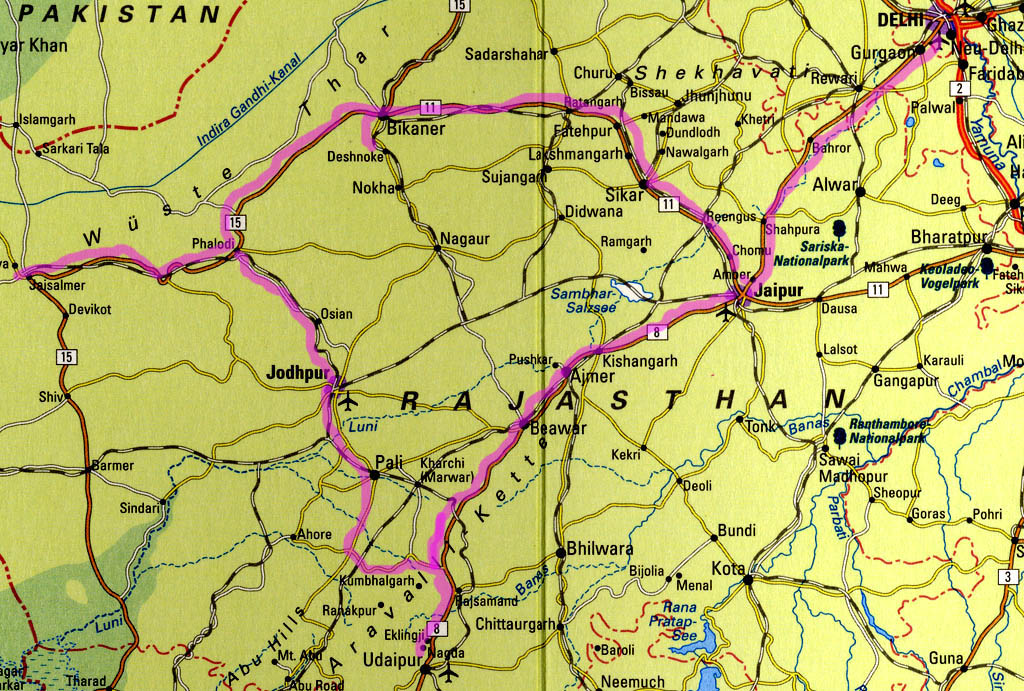Introduction
This is an abridged description of a roundtrip in Rajastan in December 2002. The intention is to give a first hand personal experience of how we, Manfred and myself, did get to and through the country. Despite the fact that we did not book anything in advance at all (except for the flight to Delhi) and that we covered about 2500 km within 19 days, it was no problem getting any means of transport or hotel accommodation at the same day, We only did some kind of pre-planning in so far that I had to be back in Delhi on the 18th day at the latest and Manfred still another week left to finish his vacation in Goa. But where is Rajastan? See following map of India.
If you want to take a look at all the photos at once and run a slide show then hit
All Photos
Getting from Duesseldorf to Jaipur
Flight from Duesseldorf via Paris (Air France) to Delhi (Air India). Arriving Delhi in the morning at 7:00 a.m. local time on Wednesday, November 26th, 2002. Getting out of the airport was fast and easy. Prepaid our taxi for 250 rupees (5,50 Euro) at the "airport prepaid taxi booth" and off we went to the Bikaner House where the luxury buses are supposed to leave for Jaipur.
But unfortunately we did not get there right away. The taxi driver made a slight detour and brought us to a travel agency where he thought he could earn some commission for the sold bus tickets. Within a second I was aware of the scam and told the taxi driver that if we miss our bus now leaving from Bikaner House, I expect him to drive us to Jaipur for the bus fare. The travel agent even had the guts to tell us that there will be no bus till the afternoon and that the Bikaner House bus station is currently closed anyway but that he is able to sell us tickets right now (he did not exactly want to tell when "his" bus will be leaving though). Anyway, our decision was made: get back into the taxi and drive to the Bikaner House right away and as fast as possible. We just arrived in time for the 8:45 a.m. bus.
The bus driver was kind enough to wait until we have bought the tickets (220 rupees, i.e. 2.40 Euro per person). That still took us 10 minutes, because the clerk had to fill it out manually with our names and age (the hell knows why they always needed our age; I did not get a discount for seniors anyway). At 9.00 a.m. we finally started. The "luxury" of the bus was a little bit exaggerated. But believe it or not, we did get a bottle of mineral water. The ride was O.K. so far and we arrived in Jaipur at about 2 p.m.
But here again hassle with the taxis, but different. First of all we did not arrive at the main bus station as we would have expected but at some place at the outskirts. We were almost pulled out of the bus by several auto- and cyclo-rickshaw drivers. Every body wanted to carry us somewhere. We picked one auto-rickshaw driver. But before we could head off we were directed to buy some prepaid ticket for a sum of 175 rupees (3.80 Euro) at a ticket street stall. Oh yes we did get a ticket, not preprinted but a manually filled out one. That all seemed to be a Transportation Mafia and everybody gets their commission: the bus driver, who stops before reaching the main bus station in the center, the pre-paid ticket seller and some kind of an "union" in the background. Our auto-rickshaw driver told us that he will only get 50 rupees out of these 175 rupees.
So no wonder that he tried to bring us to other hotels (for more commission) than we have asked him to drop us off. This was the first and only bad experience dropping off in a strange town. For all the future "arrivals" we took our gear and went out of sight of all the "welcome" drivers and then took another means of transport just coming along the street after a fixed price was agreed, usually not more than 50 rupees.
Some words to bargaining, tips and bakshees
Some people may say that this is exploitation, because the demanded higher rates are still a lot less than what we would pay in western countries. However, they will still make both ends meet with their local market prices (it may also spoil and increase the prices for the locals until they can't afford it). Any more money will be like bakshees for them. And I am rather giving bakshees and a little more to the street children, but not to the children in the street but to a trusted organization, for example the
SOS Children Villages (SOS-Kinderdorf)
who will get the children from the street and will provide also all means to keep them away from it. I also do not give any bakshees to children who are terribly and arbitrarily crippled and mutilated by their parents or their "custodians" just for the purpose of yielding more money through begging, but not necessarily for their own benefit. The more you give the more children will be crippled and mutilated.
Staying in Jaipur
Finally, the auto-rickshaw driver dropped us off at our preferred destination: the Bissau Palace Hotel. We picked it from our "Lonely Planet" guide book as the one affordable Rajah's Palace for 990 rupees (22 Euro) for the double room. The Rambagh Palace would have come to 260 Euros. The rooms are budget guesthouse standard in another than the main building, but with two big "antique" wooden beds and with weapons on the wall. The bathroom even was more than modest, but had warm (not hot) water. The main building had a nice lobby, a wood-paneled library and two restaurants (one on the rooftop). All with lot of old photographs from the good old times. The Rajah Family was supposed to still live in the palace, but on the upper floors. The park, the swimming pool and the tennis court were a little bit run down. But altogether: still worth a stay here for that kind of money.
Click the small picture to get it large.
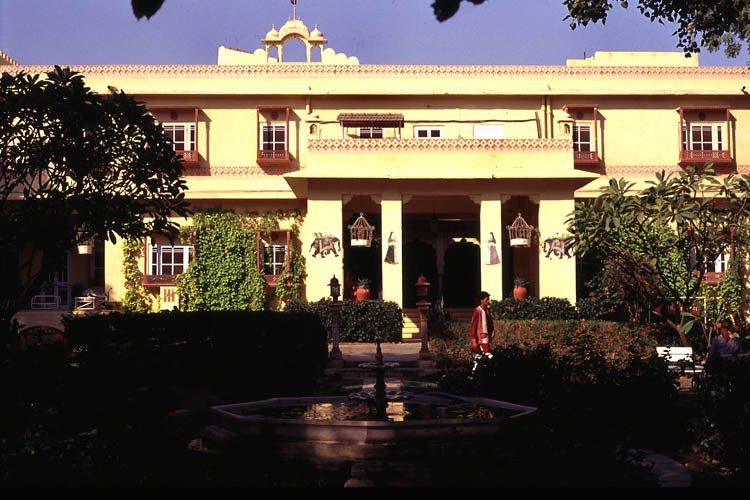
| Bissau Palace Hotel Entrance
|
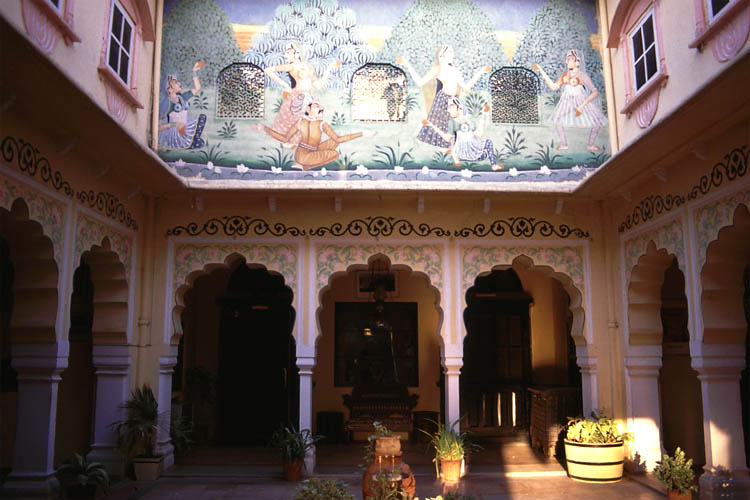
|
Inner court
|
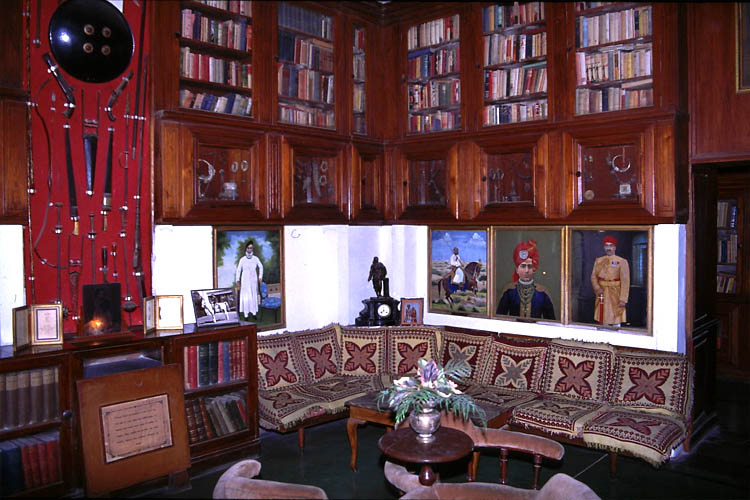
| Library
|
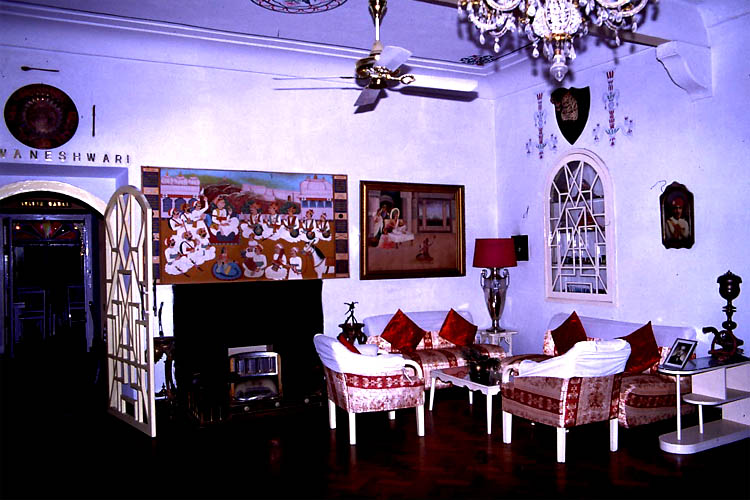
|
Lounge
|
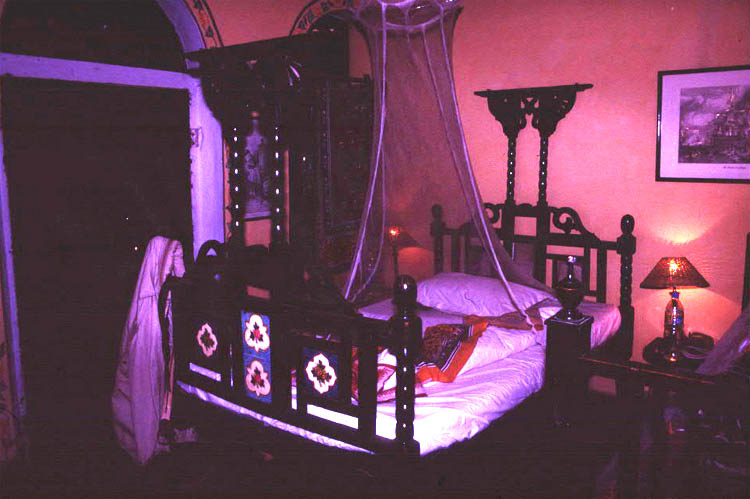
| My bed
|
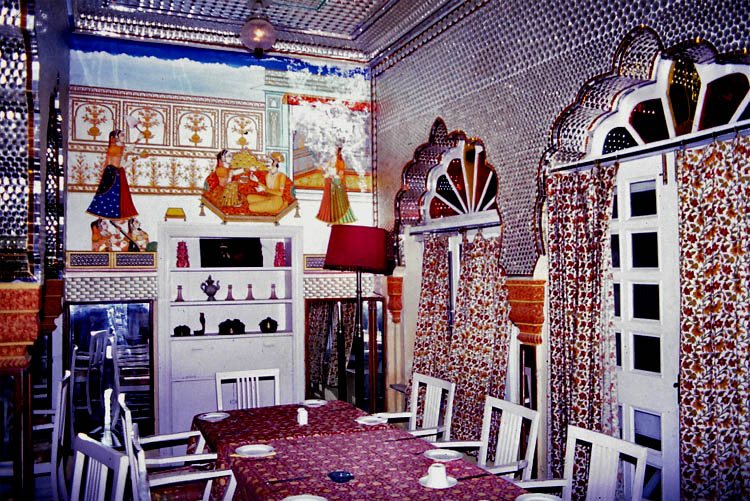
|
Restaurant
|
The Bissau palace may have had even Charles and Diana as guests. At least they went on a tour to the Bissau hunting pavilion, 27km away, with camel carts while visiting nearby villages. That tour is still offered to everybody.
Sightseeing in Jaipur
The east gate to the old city of Jaipur is not far away from the Bissau Palace, just a short walk through the Moslem Quarter (the Muezzin call early in the morning was a little bit annoying, though). After passing the East Gate you are right in the middle of it all: bazaars, bazaars, bazaars.
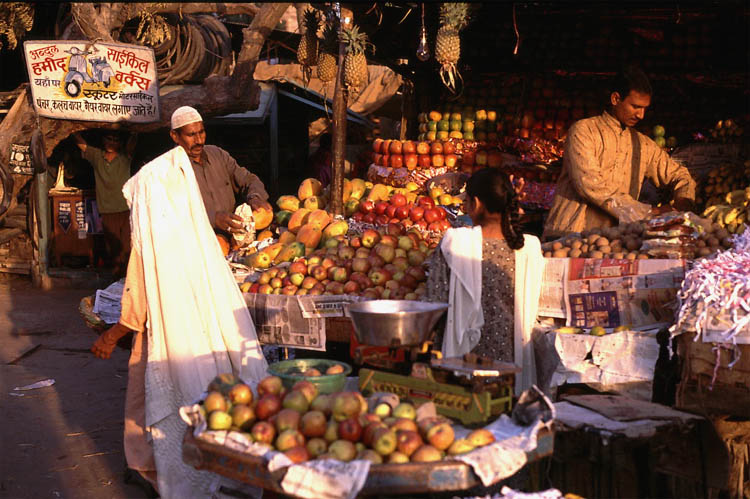
| Fruits, fruits, fruits
|

|
Vegies, vegies, vegies
|

| Cows, buses, rickshaws
|
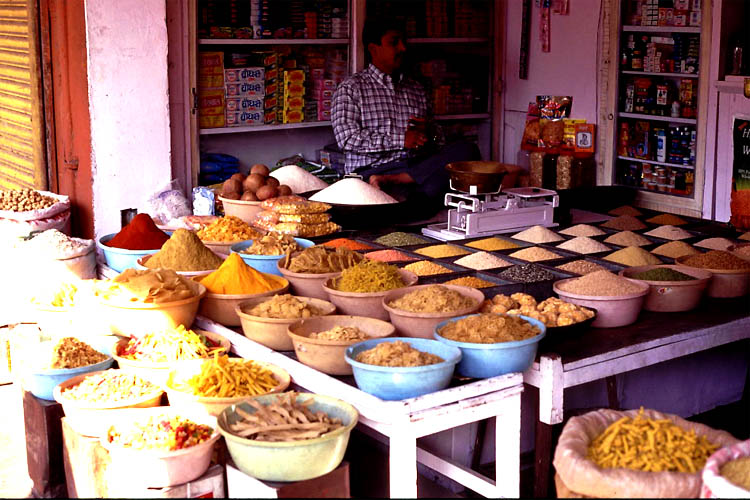
|
Spices, spices, spices
|
Then you encounter a lot of temples in between all the bazaars. Also one of the most famous and main tourist sights: the Palace of the Winds, only build for the ladies of the maharaja to take a look to the street life and the parades when they take place (they were not allowed to leave the palace compound).

| There it is: The Palace of the Winds
|
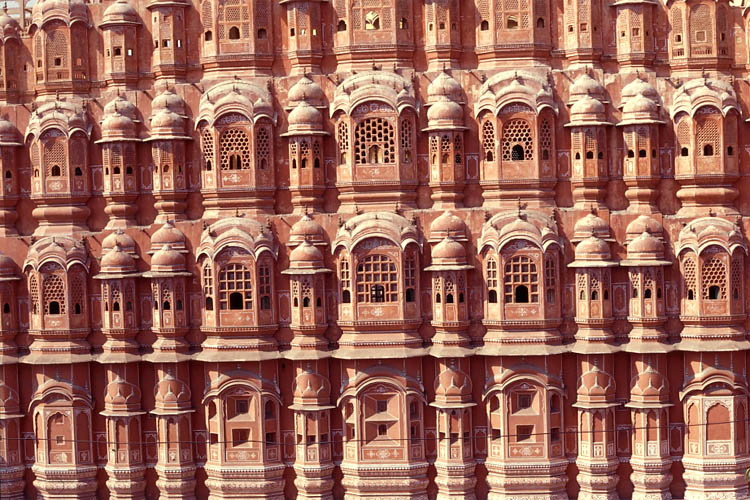
|
with the impressive front
|

| but nothing behind
|
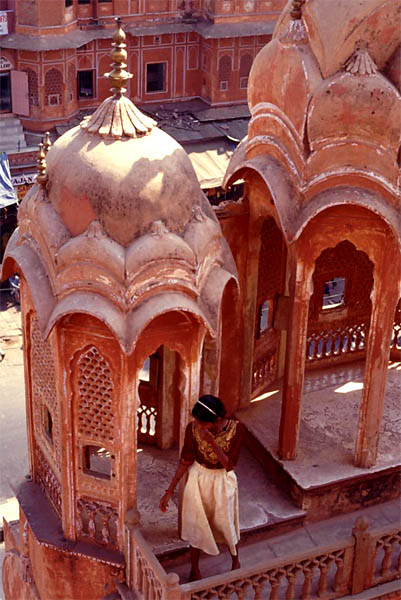
|
except the grand stand (or sit) for the ladies
|
Instead of hiring a car with driver we decided to make a full day sight-seeing tour of Jaipur (yes, organized, by the Tourist Office). We bought the ticket for 135 rupees (3 Euro) one day in advance (the booking office in the main railway-station is open from 9 a.m. to 6 p.m.).
First stop was at the Jantar Mantar observatory, which is really unique in the world. Not just one but many constructions build to prove different astronomical "laws", some are just sun clocks. It was build in the 18th century by Jai Singh, whose passion for astronomy was more notable than his prowess as a warrior. Look up your Guide Books if you really want to know what each of the constructions are supposed to mean.
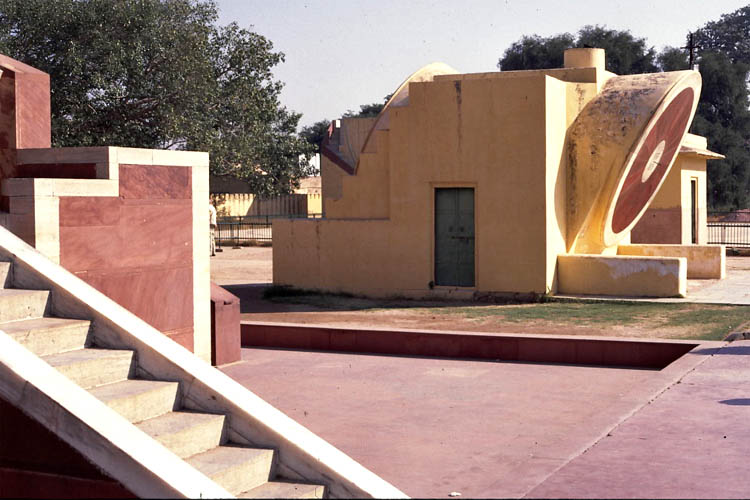
| One of the construction of the Observatory (Jantar Mantar) in Jaipur
|
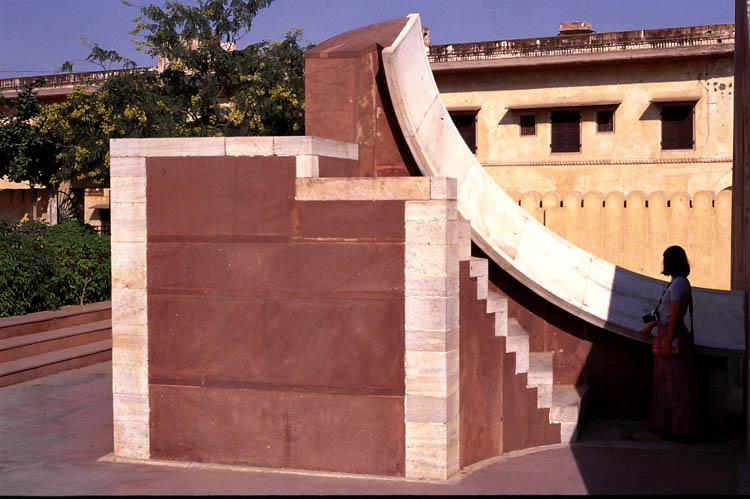
|
What time is it?
|
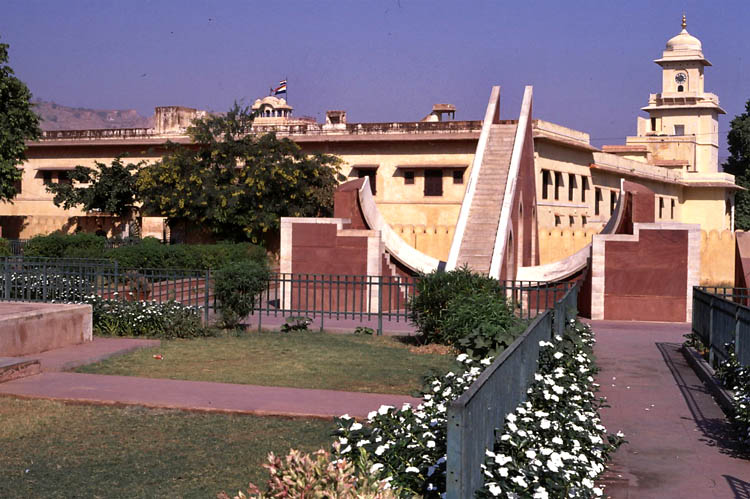
| At noon to walk up the stairs?
|

|
Stairs to heaven or to have a better view of Tiger Fort (on the hill)
|

| Hit the gong every hour?
|
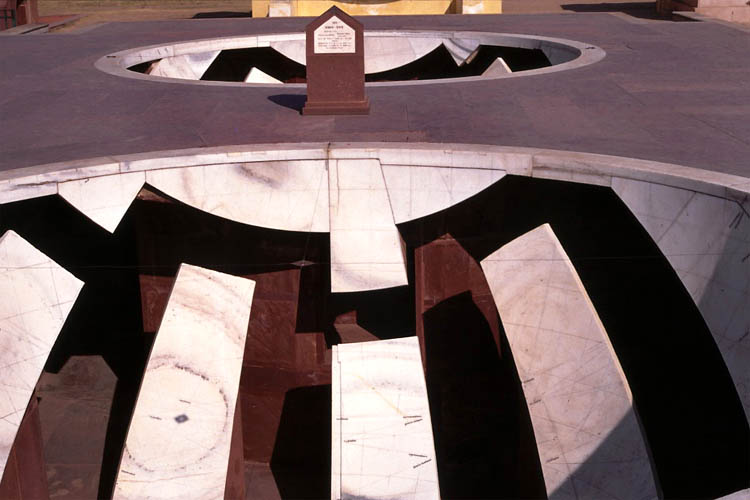
|
Can't follow the stars?
|
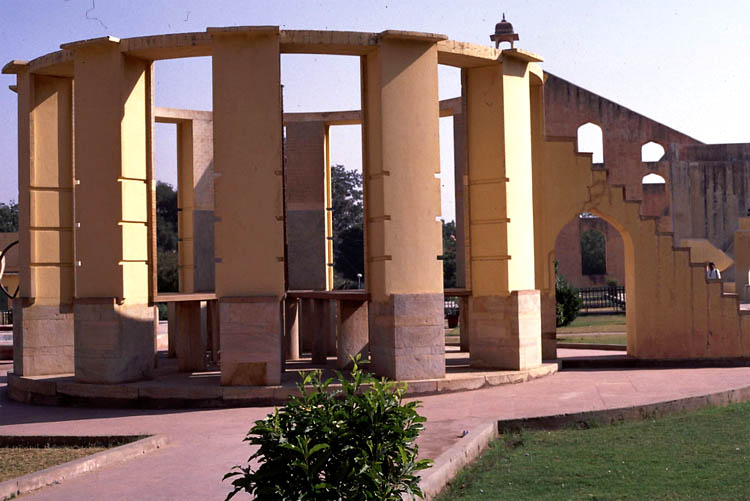
| Modern Stonehenge?
|
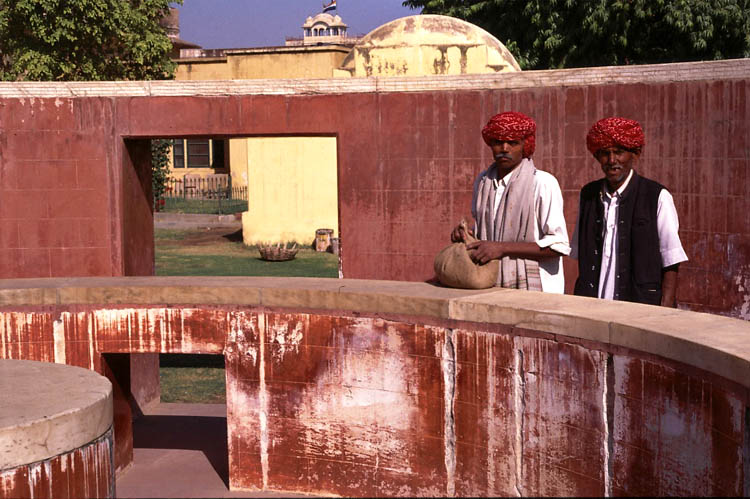
|
The Indians didn't understand that thing either
|
Next came the City Palace tour in the heart of the old city. Part is still used by the last maharaja and his family and the other as a museum. Remarkable are two silver vessels which the Maharaja Madho Singh took to London. They were 160cm tall and filled with 9000 liter Holy Ganges water each, because he did not want to risk the "polluted" English water. He probably would not have used the really polluted water from the Ganges in Varanasi today.
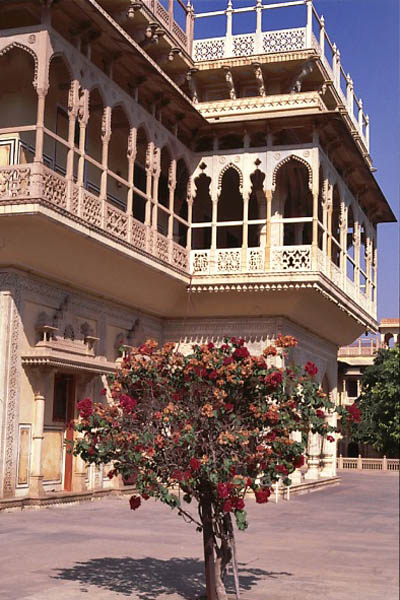
| City Palace in Jaipur
|
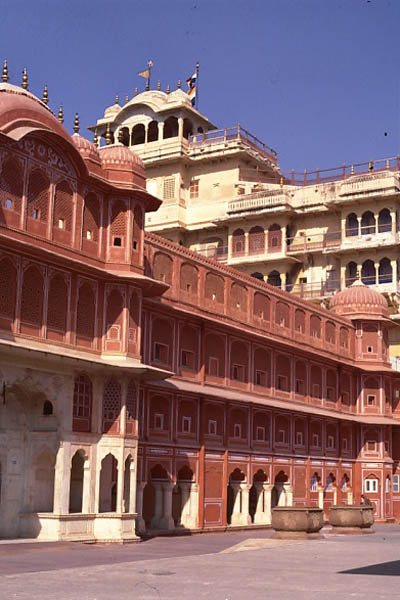
| See the "Penthouse" of the Maharaja?
|
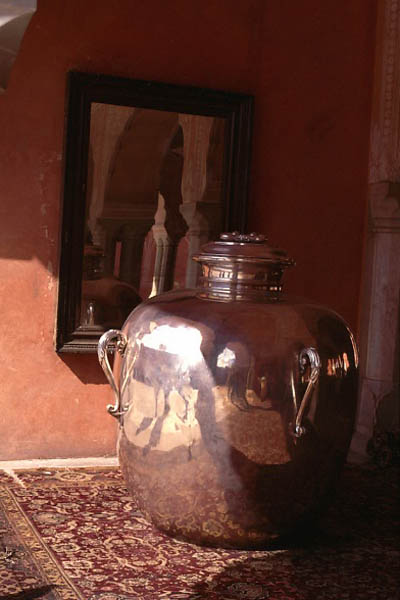
| A little bit heavy for silver collectors
|
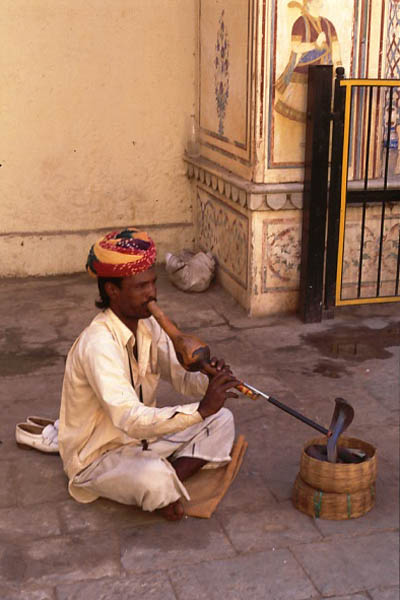
| Cobra on Guard at the Gate
|
Then we continued to our next destinations: A Fort far out located on a hill. I really forgot the name of it.
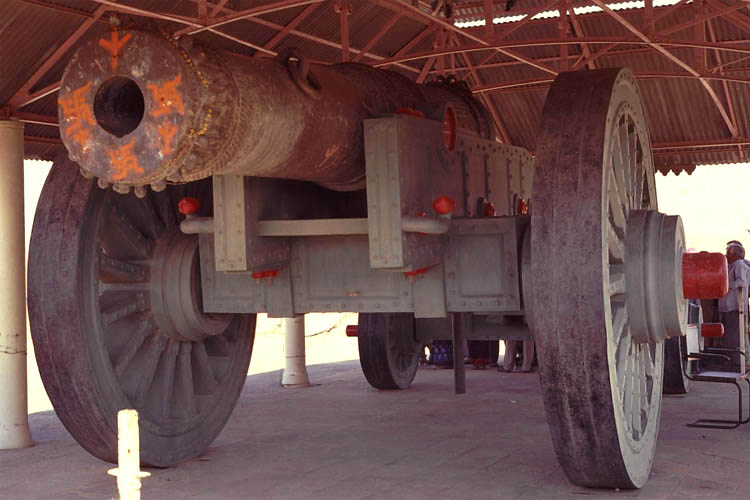
| That cannon did not hinder us
|
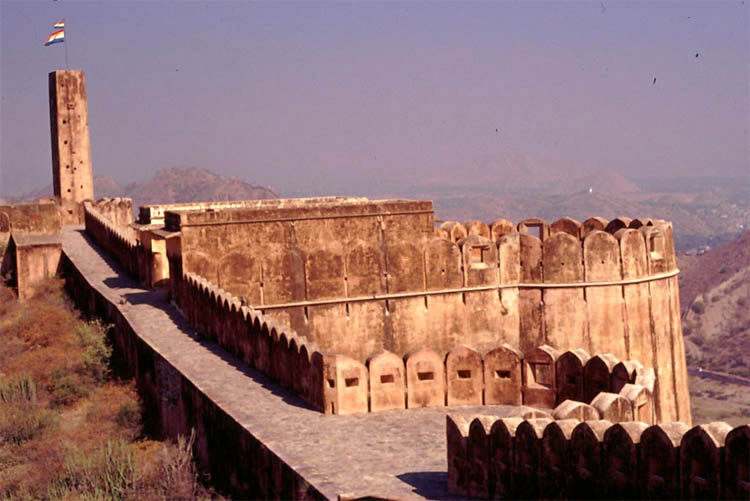
|
to climb and conquer the Fort
|
Next stop at the Nahargarth (the Tiger Fort) which overlooks the city of Jaipur, where we had lunch.
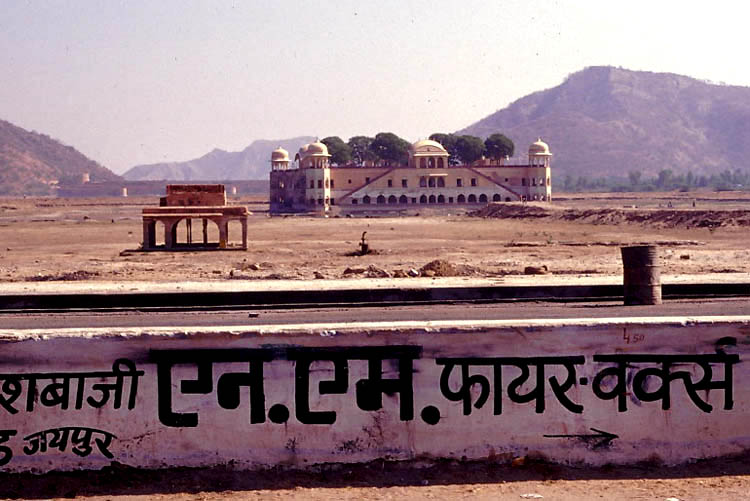
| Passing a water palace in a dried up lake
|
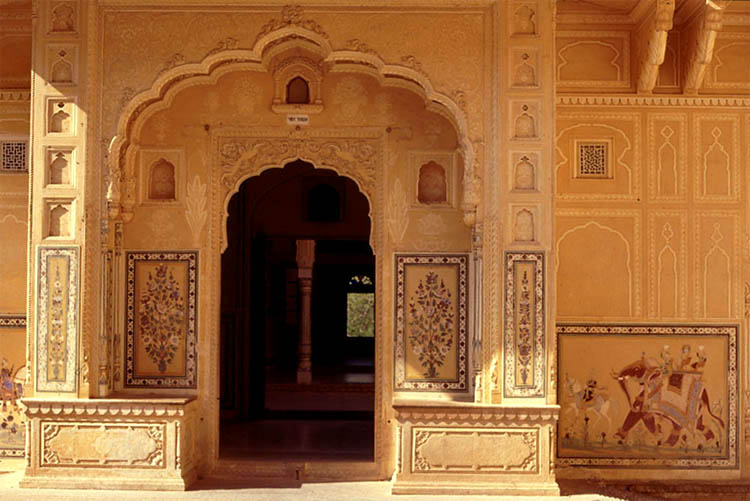
|
One of Tiger Fort's inner courts
|
Then we reached the famous Amber Fort located on a hill 11km from Jaipur. It was once the capital of Jaipur State. It has four sections, each with their own court yard.
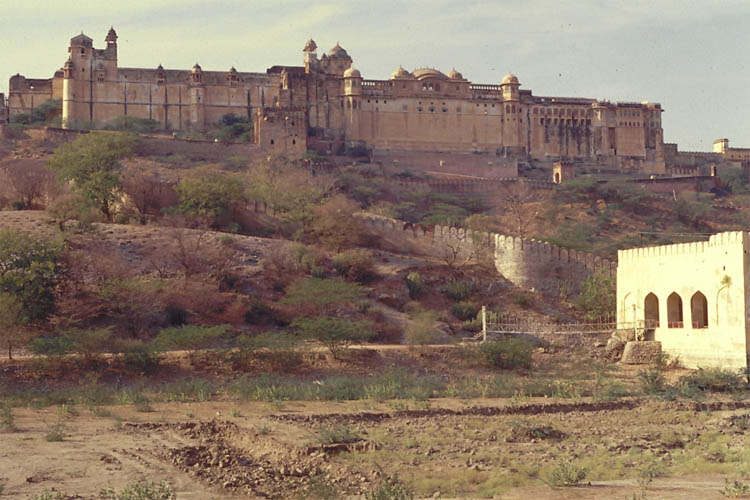
| Quite impressive.
|

|
One of the court yards
|
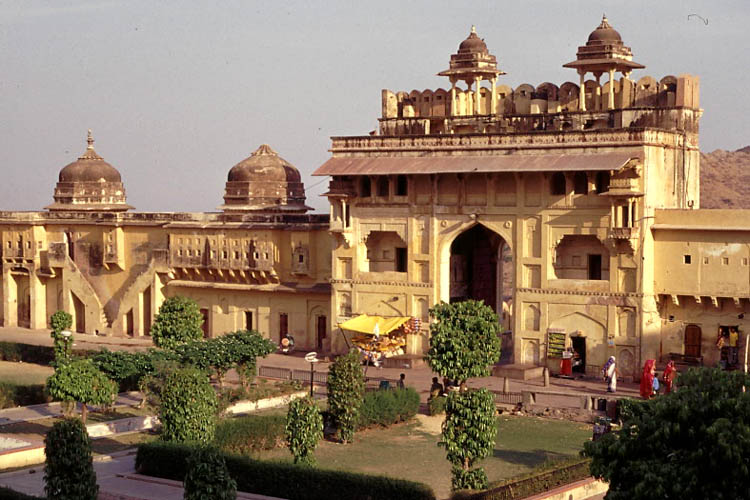
| A tranquil place
|
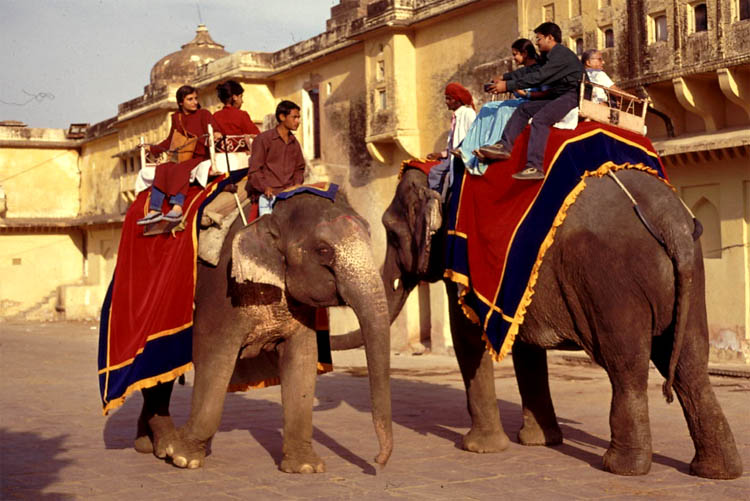
|
and a tourist attraction
|
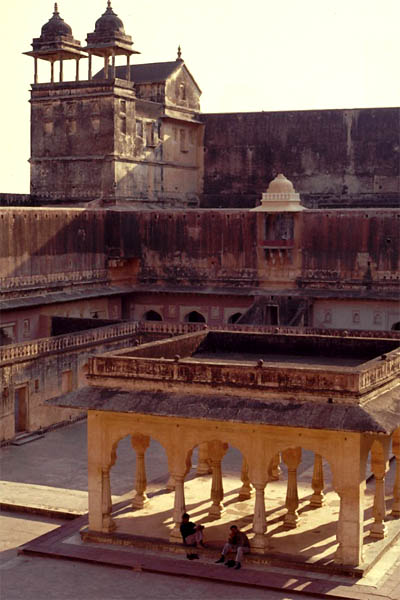
| Another court yard
|
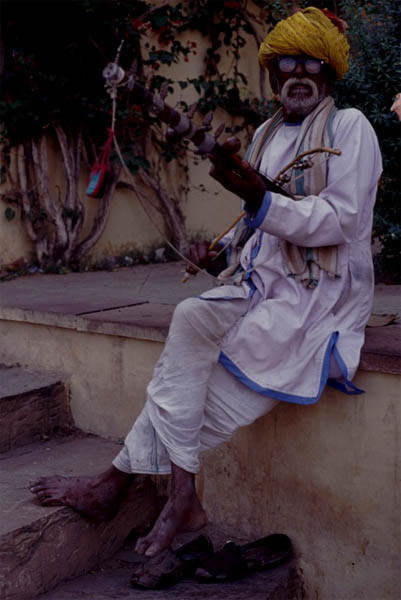
| and a fiddler at the entrance
|
That whole tour really was fantastic to get an overall impression of the impressing old remnants of the Maharajas of Jaipur. There would have been much more to explore but we had to continue to complete our planned roundtrip. In order to save time we decided to take the night train to our next destination: Bikaner. Before we had to leave we strolled around in the new part of Jaipur (outside the old city wall).
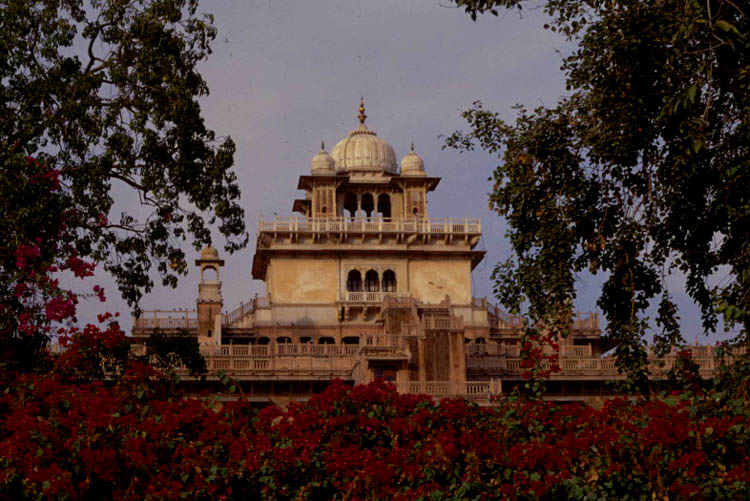
| Another nice sight
|
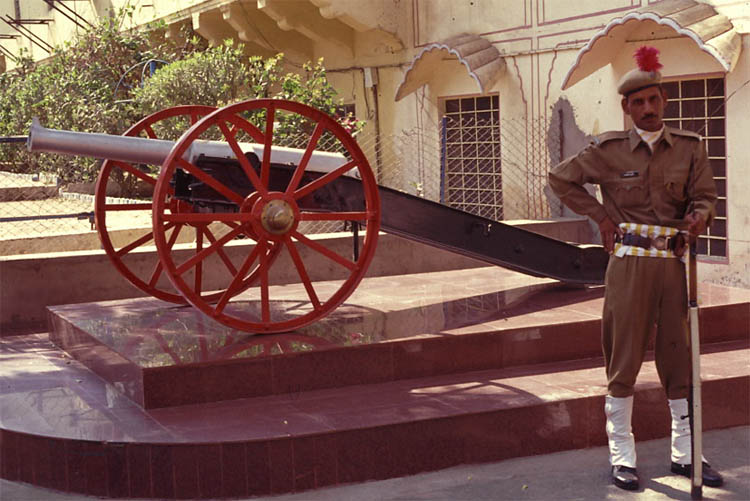
|
and the Police HQ nearby
|

| Woman are construction workers
|
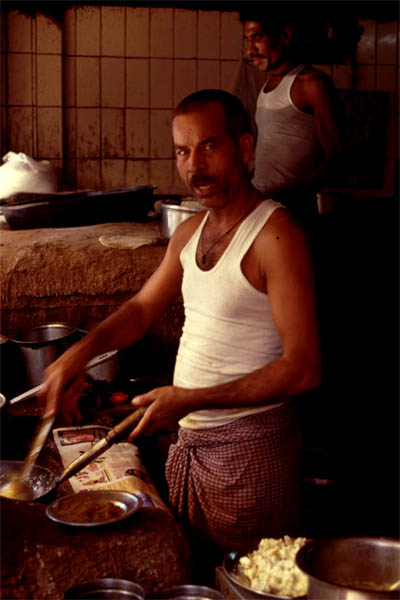
| and men are cooks: Indian's Emancipation
|
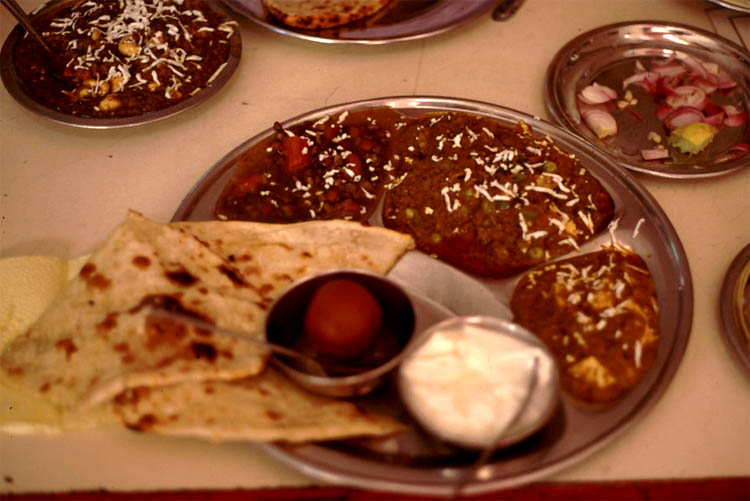
| Our last meal before we hit the rail
|
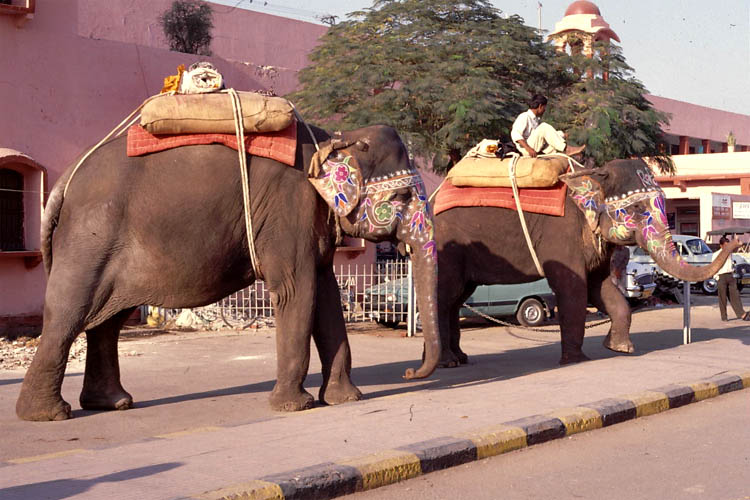
|
and not the elephant trail (though they are waiting at the railway station)
|
The Jaipur-Bikaner Express left at 9 p.m. and arrived at 7 a.m. next day after 517 km. The fare was 176 rupees (4 Euro) for a non air-con sleeper.
That was the worst night on a train I ever experienced. It was a sleeper and non air-con, alright, nice bedding and no freezing air, I thought. But the contrary: Hard long bench and freezing air coming through all holes; no blanket was provided. Put on everything I had, covered me with my thin cotton white sleeping (hostel) bag, which was not white anymore on arrival but stark dirt black from all the dust and garbage in the compartment
Bikaner
Directly from the railway station we went by rickshaw to a hotel I have first chosen from the Lonely Planet, the
Hotel Harasar Haveli
Tel.: 209891
Email: harasar_haveli@yahoo.com
|
It looked very nice and the rooms were clean, so we decided to stay. The room rate was 200 Rp. The hotel had a nice view (also to the stadium close by) from the rooftop restaurant. There even played a life band with folk music and songs in the evening. But before that, we had breakfast first and then relaxed a little (really needed after that terrible train ride). The hotel is a little outside, but all the sights can still be reached by foot. So we started to walk in the direction to the old town.
First we passed the Fort Junagarh. One of the most impressive forts and palaces in Rajastan and joining a guided tour is a must (included in the price of the entrance ticket). The surrounding wall is almost 1 km long. Despite the fact that it was not build on a hill like the other forts, it was never conquered.
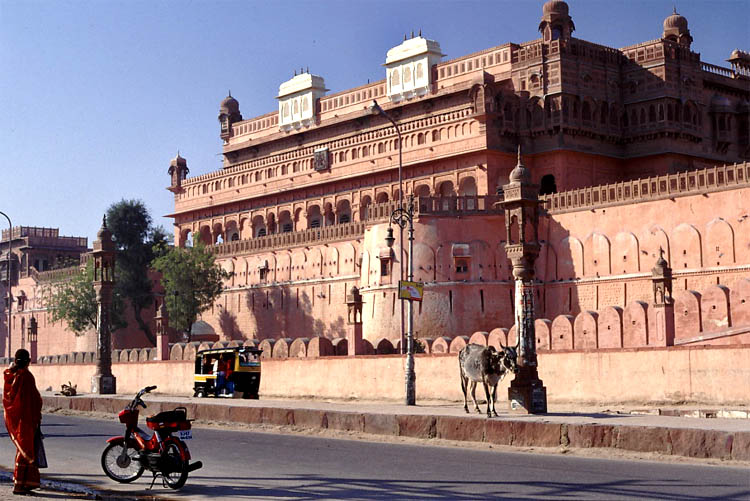
| Impressive Junagarh
|
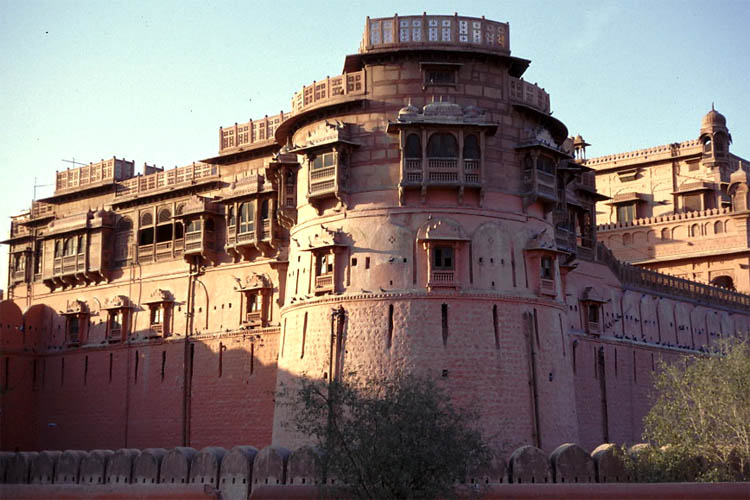
|
with one of the many bastions
|
Then we came to the old town, which was more interesting than the walled city of Jaipur. This desert town was an important staging post on the caravan trade routes (like Jaisalmer), and the inhabitants became wealthy through trade and catering to the needs of the camel caravans. So the old splendor still shows everywhere. beautifully ornamented buildings, almost palaces.
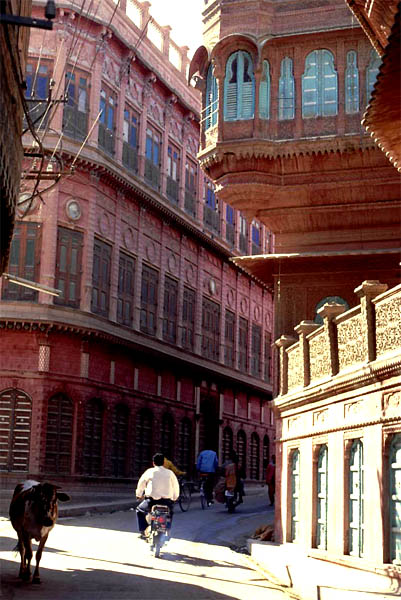
| Houses of wealthy families
|
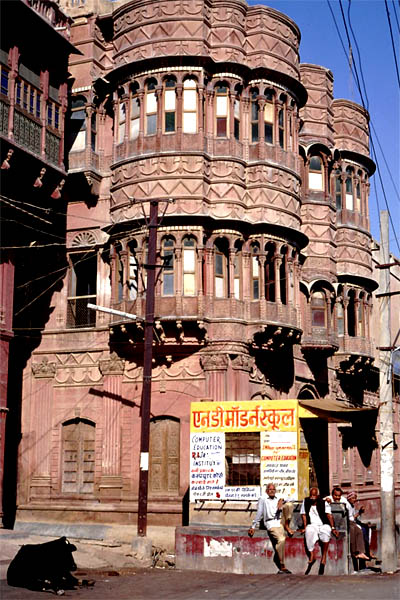
| but some are slowly decaying
|
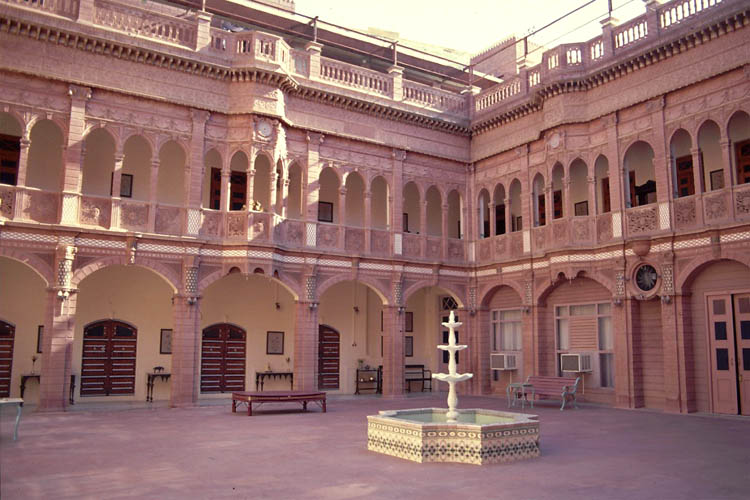
| This has been changed to a hotel, though,
|

|
with limousine service once repaired?
|
The street life was almost like in the old days: Local folks going after their businesses and markets all around with some temples in between.
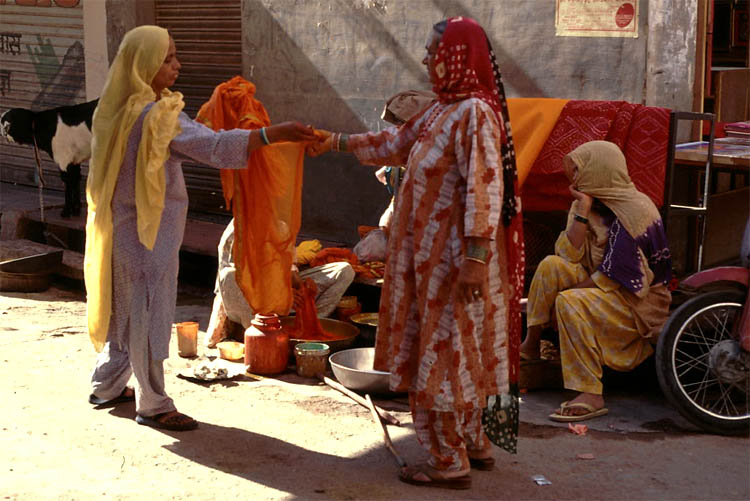
| Busy women in the color dying quarter
|
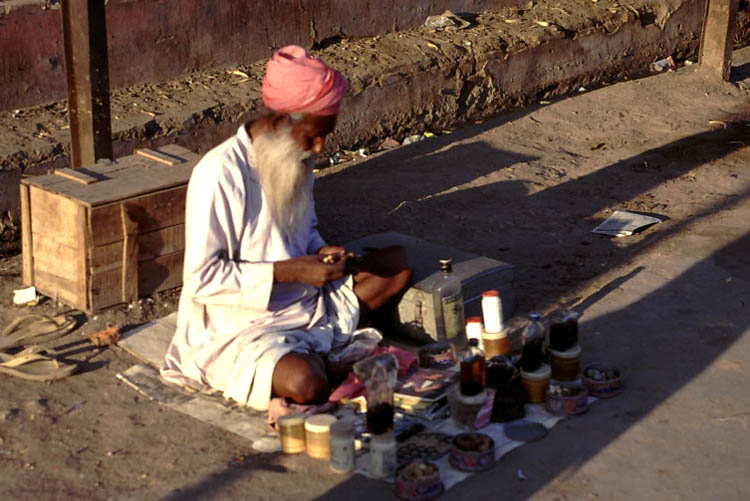
|
or an old man selling remedies
|
There are many things around Bikaner you can do. Some of them are joining a camel safari or a rat race. Since there will still be a better chance for a camel safari in Jaisalmer we decided to race to the rats through the desert to Deshnok, 30 km from Bikaner. What about the rats now? Ok, the rats are worshipped in the Karni Mata Temple, where thousands of rats are living like in paradise, and that is unique, even in India.
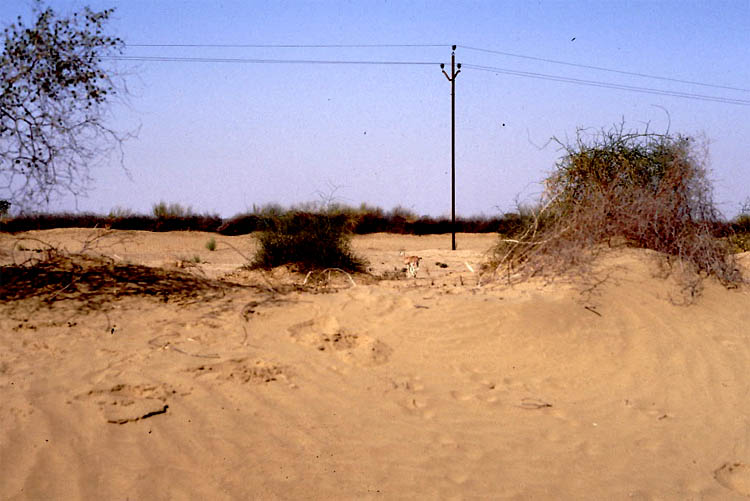
| The drive through the desert to get to the rats
|
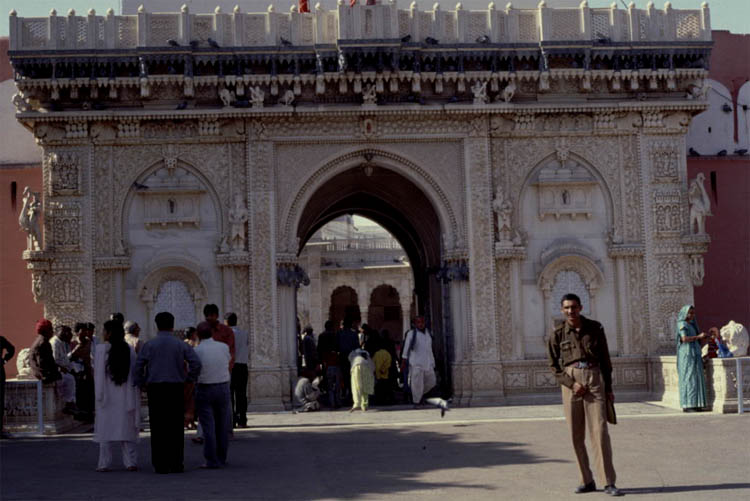
|
Finally reaching town and the entrance of the Rat Temple.
|
It happened someday in the old days that somebody in that town did get the weird idea that his deceased father (or mother) has been reborn as a rat. The Karma of the deceased probably wasn't that good enough to be reborn as a human being. So he started to feed all the rats because he did not know who was his father (or mother). He also made the other folks believe that their ancestors have been reborn as rats, and they followed his example and eventually a temple was build to worship and cater for all the rats in town. Maybe also a good idea to get them out of the house. Ok. that is my story. The "official" one has, of course, a religious background and can be read under
www.karnimata.com

| Here they are, drinking sweet milk
|

| Is this your deceased grandfather?
|
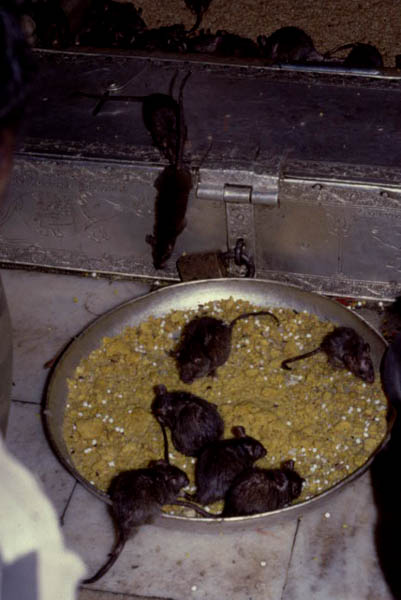
| For rats always a feast
|

| Really worshipped is every beast
|
Walk around in old socks (no shoes allowed anyway) and throw them away after, because they are full of rat's holy shit. If barefoot then get to wash your feet after and clean them with some antiseptic solution (ought to be done after wearing socks, too). By the way, you may have luck not getting any infection, if you have seen a white rat, which is very seldom.
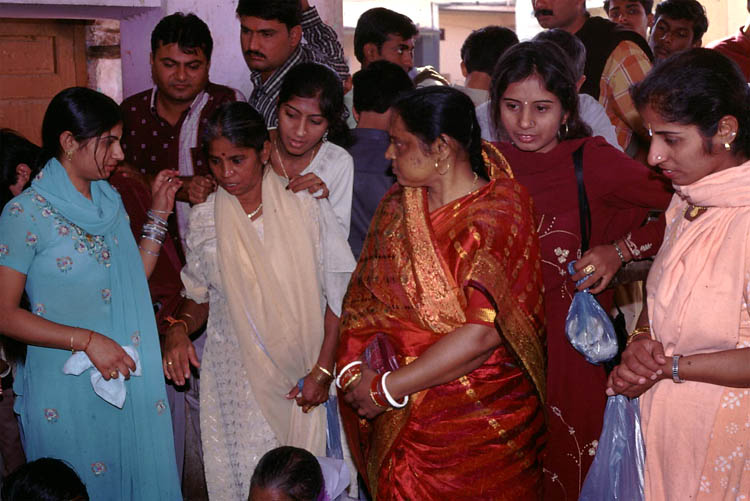
| More worshipper looking for their relatives and especially for a white rat
|
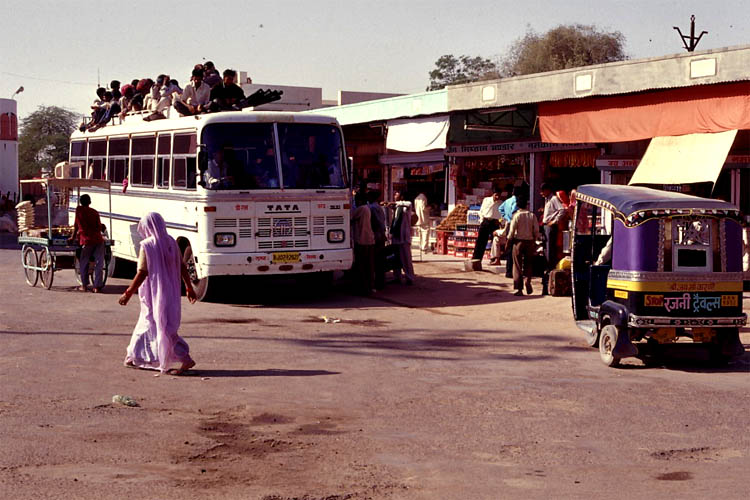
|
Some paranoid may get out fast and jump on the roof top of the bus, last chance
|
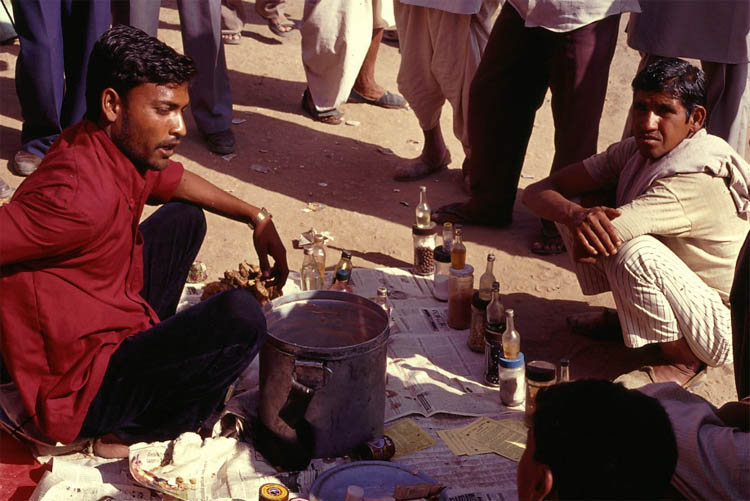
| Need a remedy for your rat allergy or for cleaning your feet
|
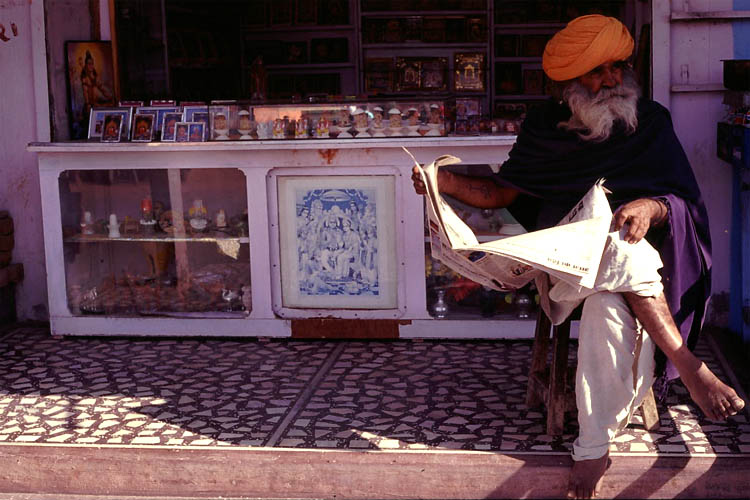
|
It seems that not many people buying a rat souvenir
|
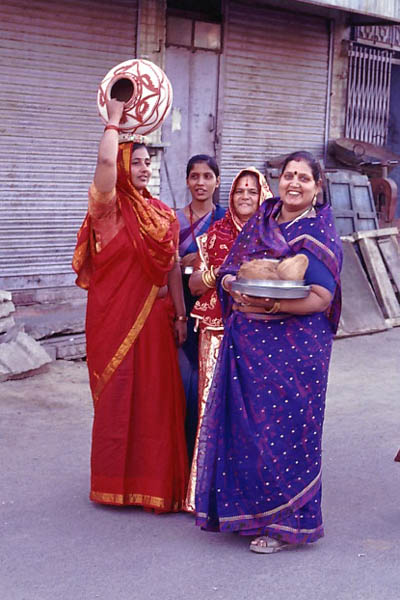
| Hey, where are you going?
|
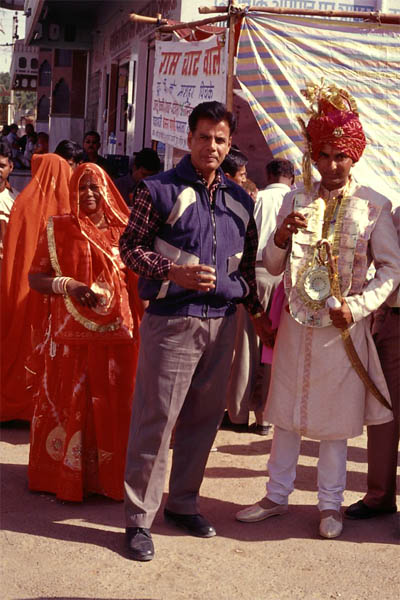
| To a wedding in the rat's temple?
|
About 9 km before Bikaner we passed by a National Research Center, where they are breeding and cross-breeding three different kinds of camels. If you own a female camel you can get it inseminated here for free, by a stud (male) who is able to serve up to five females a day. Can you? I mean, not with the camel, of course. But you can try to ride one just to get a feeling whether your back can survive a camel safari for a couple of days.
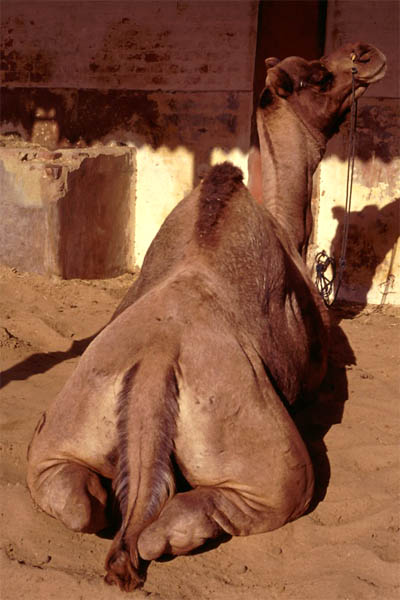
| Want to buy your own thoroughbred camel
|
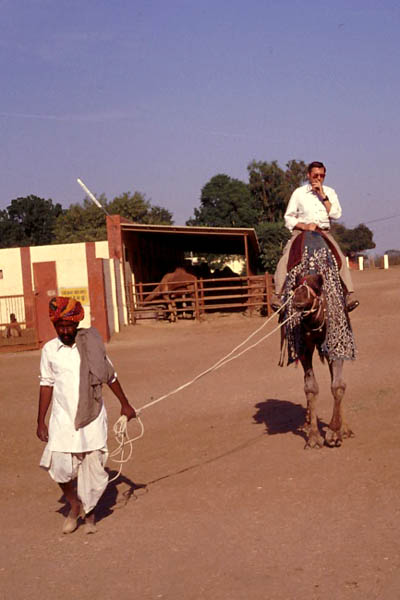
| Better test it out before you buy one
|
Back in Bikaner we just happend to encounter another wedding. Must have been a preferred day that day. The groom roamed through all over town with his horse and entourage. The real wedding is supposed to take place next day.
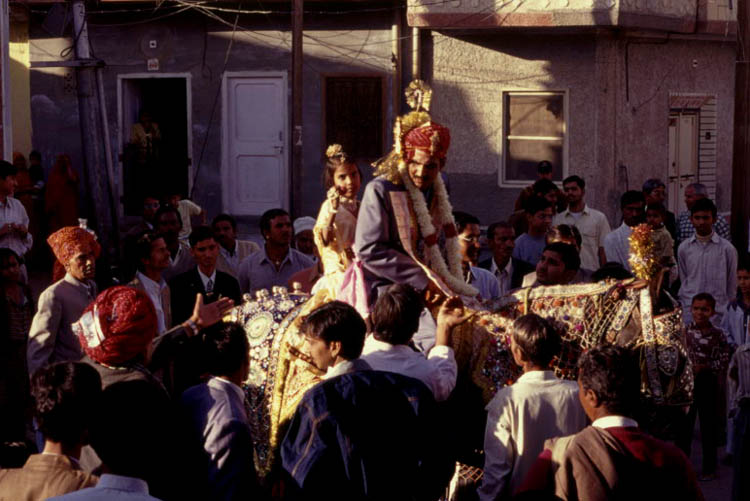
| A real wedding parade
|
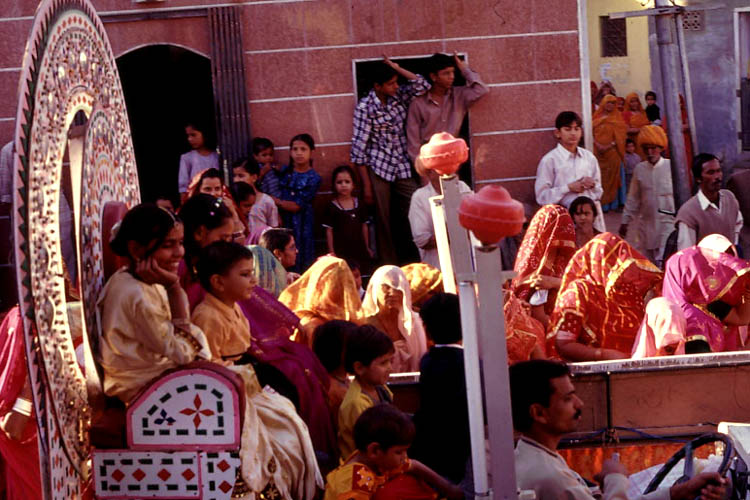
|
But were is the bride?
|
That was the last day in Bikaner. Next morning we left by bus to get to Jaisalmer
Jaisalmer
From the bus we already could see the impressive silhouette of the elevated fort of Jaisalmer. What a feeling would it have been if we would have arrived with a camel caravan like in the old days. However, our arrival was not that romantic. Even still in the bus we were approached by touts offering us the best hotel in town. More just out of curiosity we joined one of them to show us his "best" hotel. It was a newly build but terrible house with terrible rooms outside the old city in a busy street. Ok, that was it. We quickly jumped on a rickshaw and went off to the fort, where we had to get off before the gate (motorized traffic not allowed within).
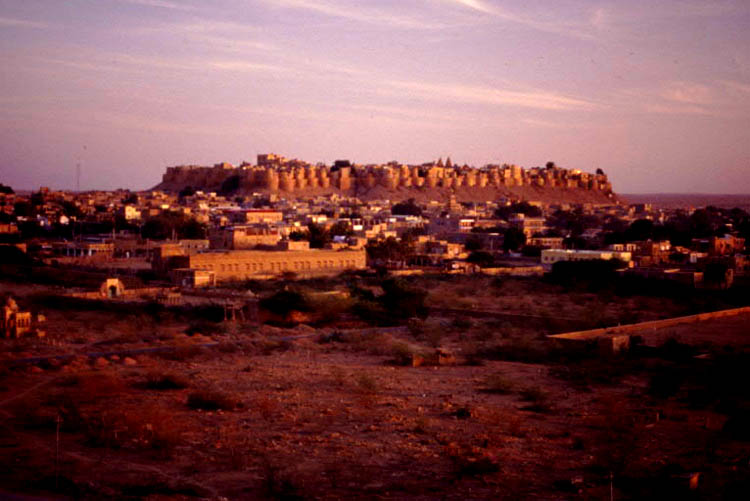
| Is this a Fata Morgana?
|

|
No, it wasn't. It has a gate to get in
|
This is also and still the passage where everybody has to go through to get into the fort. Not only noticed from above (by the guards who beat the drums if the enemies were approaching in the old days) but also by the vendors, a commercial welcome band and holy man expecting a bakshees for taking a photograph of him.

| Welcome band with folks around
|
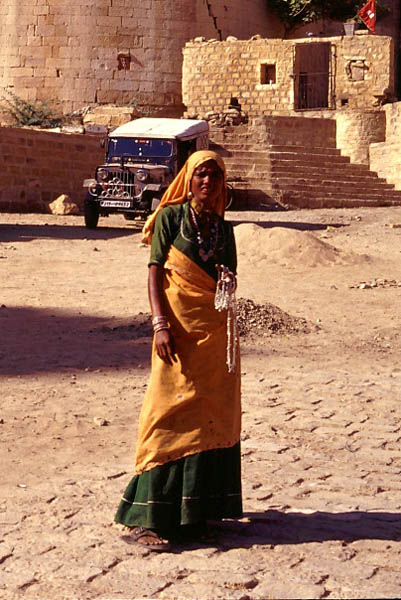
| This is not Lady Jane, but selling beads only
|
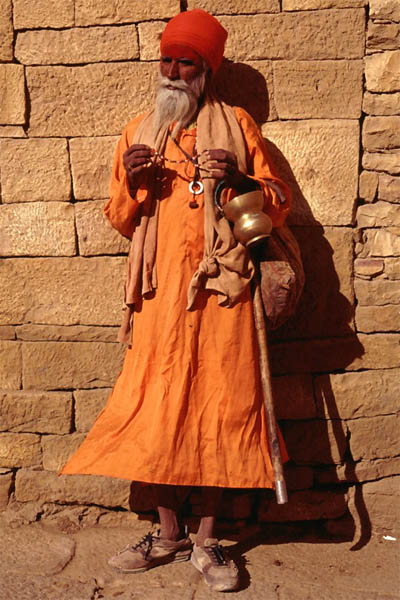
| But this may be a real Jain
|
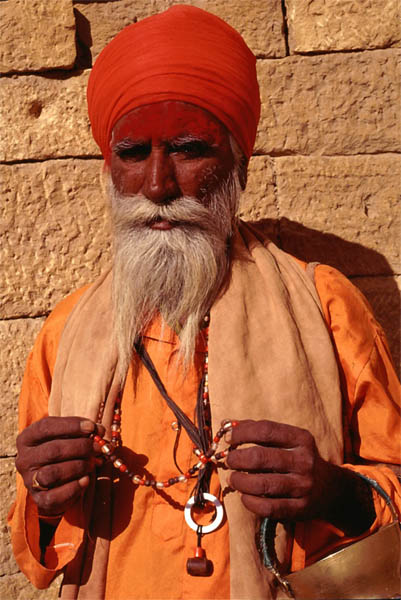
| and he is not selling his beads
|
Walking then through the several gates there was no way not to look up to the huge and high walls. Up high on top of it the seven story Rajmahal Palace.
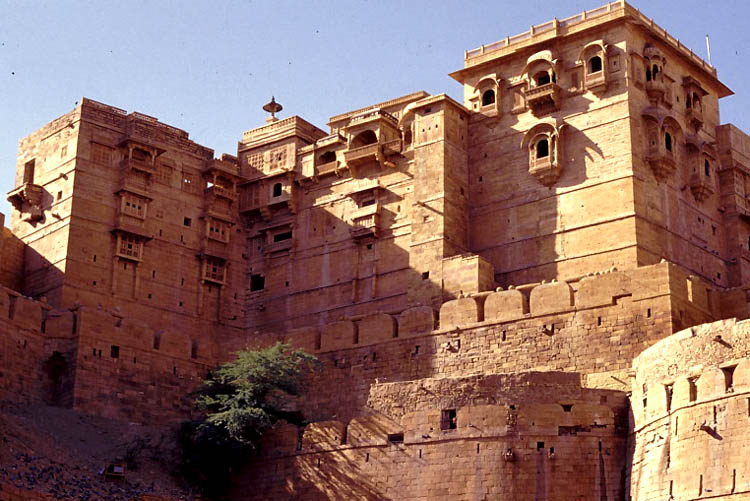
| Then looking up in awe again
|
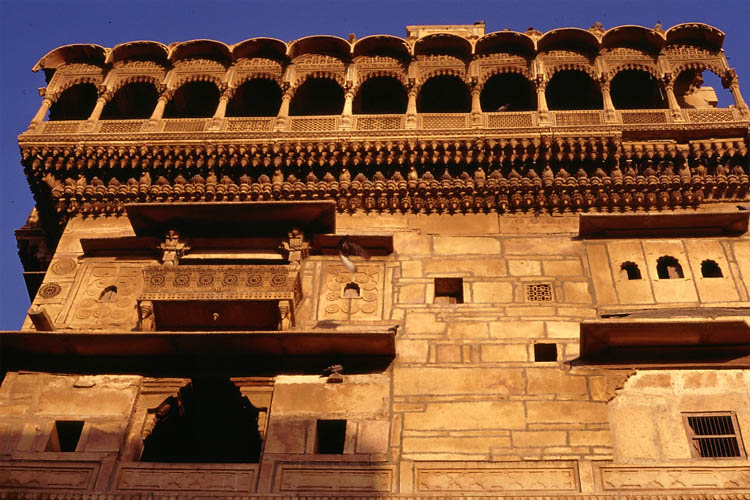
| Looking up to the palace
|
The fort was build on the 80 meter high Trikuta Hill in 1156. Over the centuries many battles took place here, especially with the rulers of Delhi and Jodhpur.
All the forts in Rajastan were more or less battling against each other with changing alliances. So Rajastan was by no means a unified state in the old days, not to mention one India. Only after the British took control over India the slaughter ceased for 150 years until all of India became independent. I may not be politically correct, but colonialism had some good sides, maybe more for the maharajas: they almost kept their power under British rule until they finally lost it after independence.
After getting through the last gate we were right in the middle of it, the Main Square. To the right the entrance of the Rajmahal Palace. Part of it is open to the public and houses a museum.
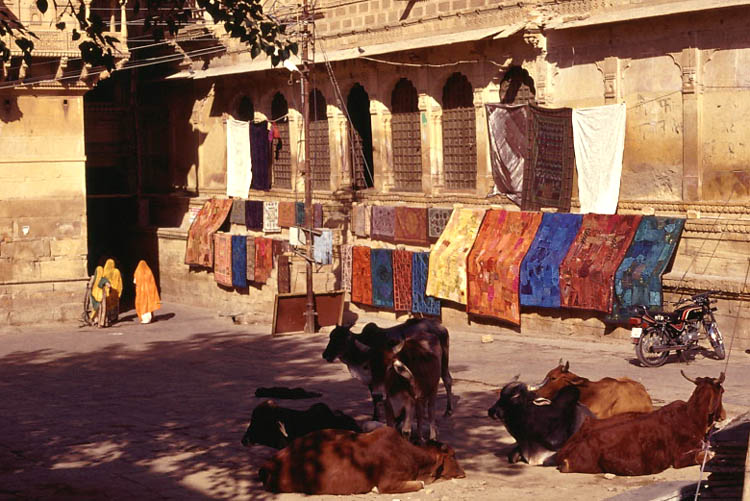
| Now we are really inside the walls .
|

| The palace seen from the Main Square
|

| From the palace you can watch the gate
|
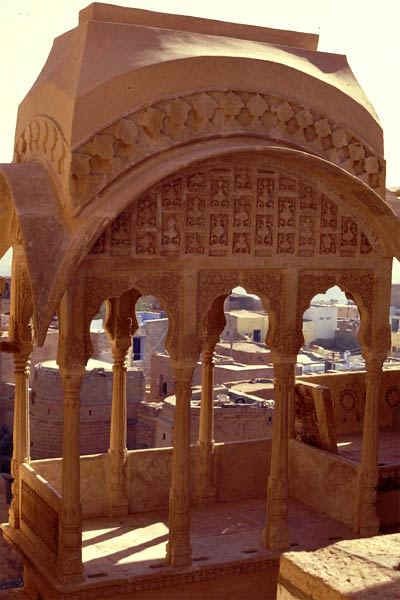
| or the inner city from the pavilion
|
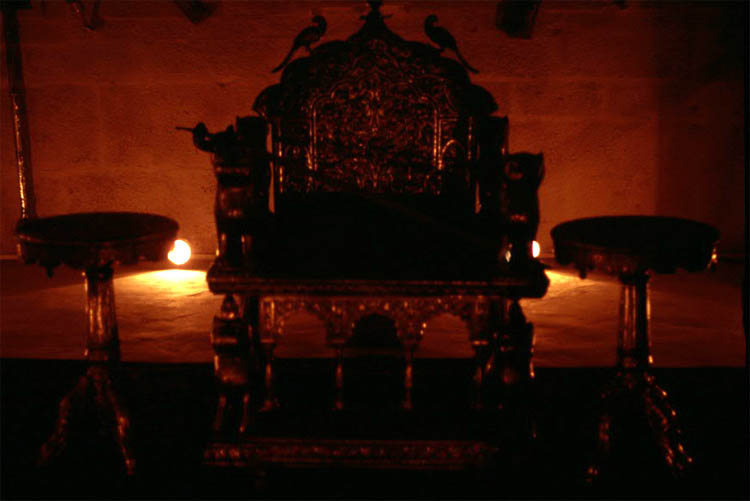
| Maharaja's seat in the audience hall, I do not want to sit in
|
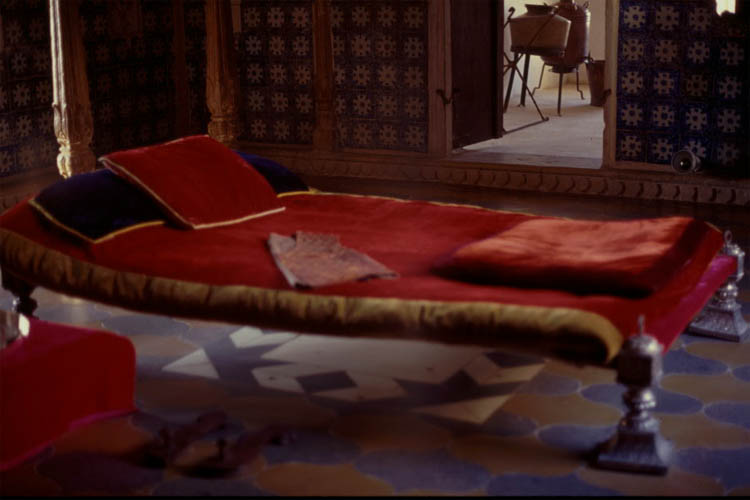
|
Maharaja's bedroom I do not want to sleep in
|
After crossing the Main Square and turning right into a small street and after a few meters you will find on the left the
Hotel Paradise
Tel.: 52674
Jaisalmer
|
A double with bathroom starts at 300 rupees (7 Euro). It can get higher if festivals are on the program. Some travelers may have had some complains about this hotel but for me it was one of the best places, especially as far as location, location, location is concerned. First advantage: it is within the famous walls, second it has a great view from the top, third is has a nice cozy courtyard and much more.
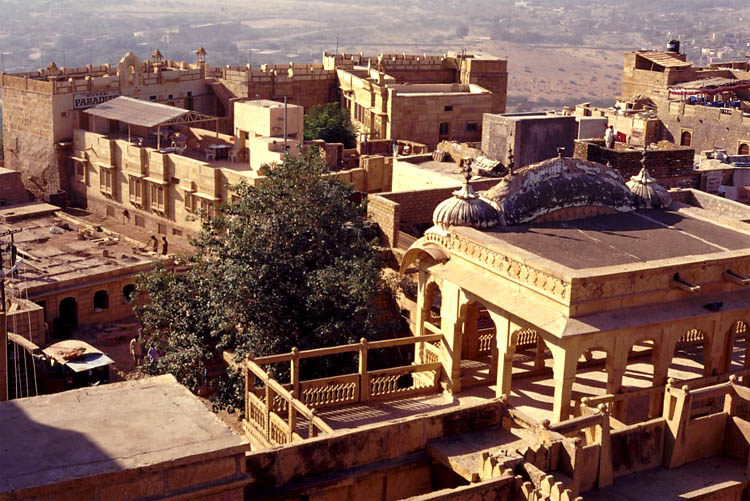
| Rather sleep in the "Paradise", which you can see from here
|
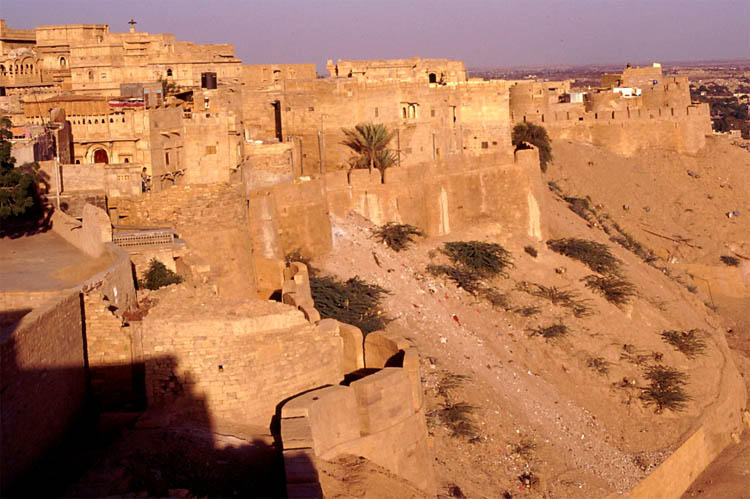
| Looking down from the Hotel Paradise
|
I comparison to other forts you can find many people still living within the walls. Many houses are still in possession of the same family for centuries. It is nice to stroll through the narrow cobblestone lanes dotted with all kinds of shops, temples (mostly Jain) and havelies, built by wealthy merchants. Some havelies have become hotels (just ask to take a look inside) and some are now private museums.
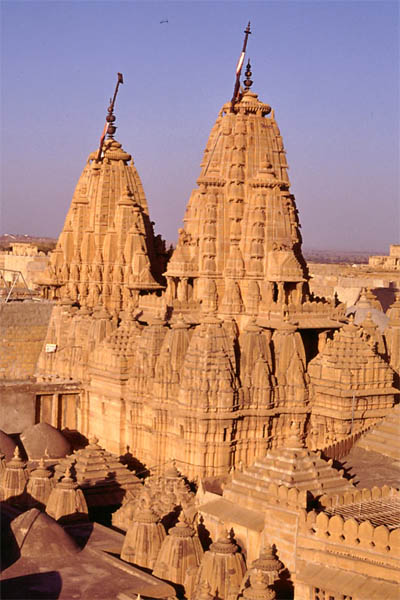
| Praying in the Jain Temple
|

| One of the Havelis
|
Instead of joining a sightseeing tour offered by the tourist center we rather wanted to be independent and hired a jeep for the whole day with driver (and guide in one person) to see the other interesting places around Jaisalmer. You can always see jeeps standing in front of the Amar Sagar Gate. Just look for the driver and negotiate a deal. Going rate was 1000 rupees (23 Euro). I forgot how much we really paid in the end.
The first place we visited was called Bada Bagh. This oasis with its electricity generating dam and windmills was not so interesting but the so called chhatris of former rulers. A Chhatri is either the site of the original cremation of a deceased or just a monument to honor the dead (as a cenotaph) and the burial ground then may be someplace else.
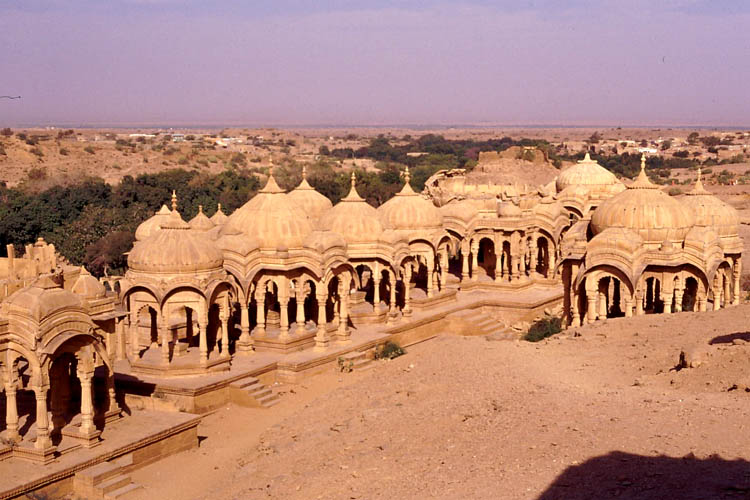
| Old memorials of former rulers
|
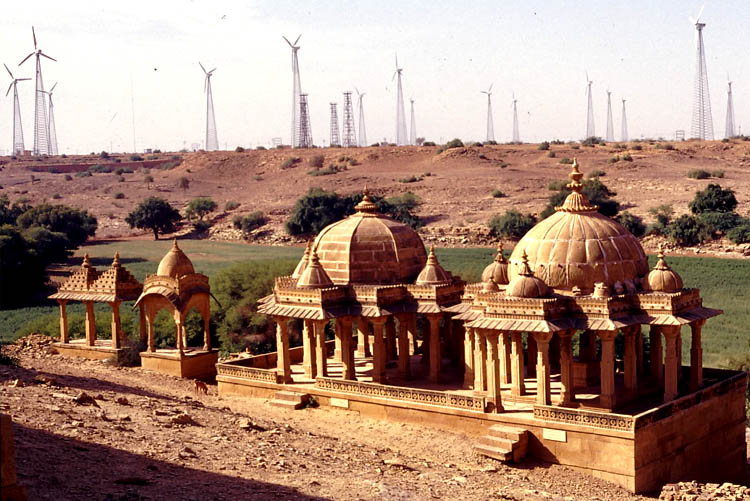
| surrounded by modern wind mills
|
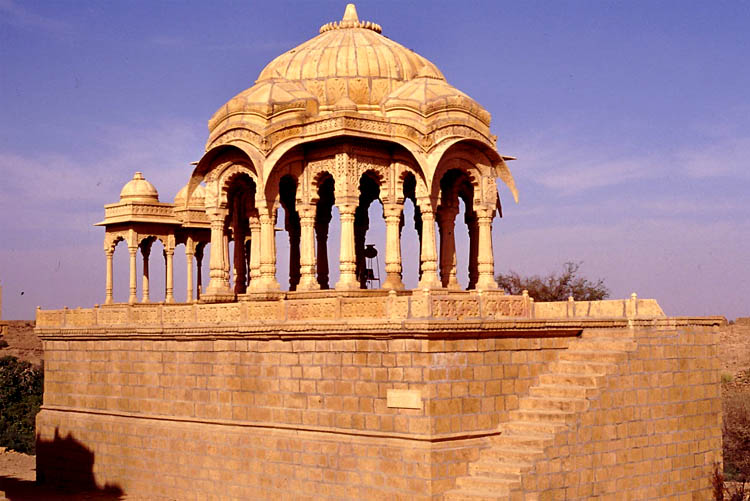
| Single royal chhatri
|
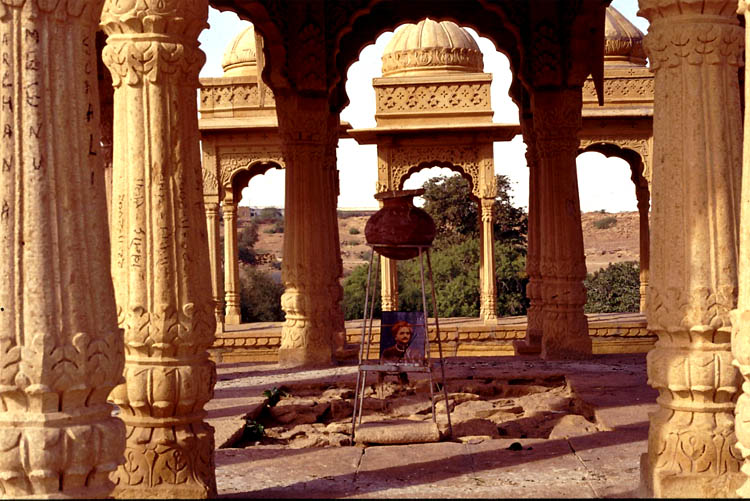
| with a picture inside
|
Next we visited Amar Sagar, or whatever was left of the garden with its lake, which was dried out (no rain fell in this area for a couple of years). Women are again working hard digging out and carrying sand to any of the houses being built. The "lake" is surrounded by a wall like of a tank. It must be idyllic if filled with water and everything green and blooming all around, like in the Jain temple compound bordering the "lake" (could still use some more water, though)..
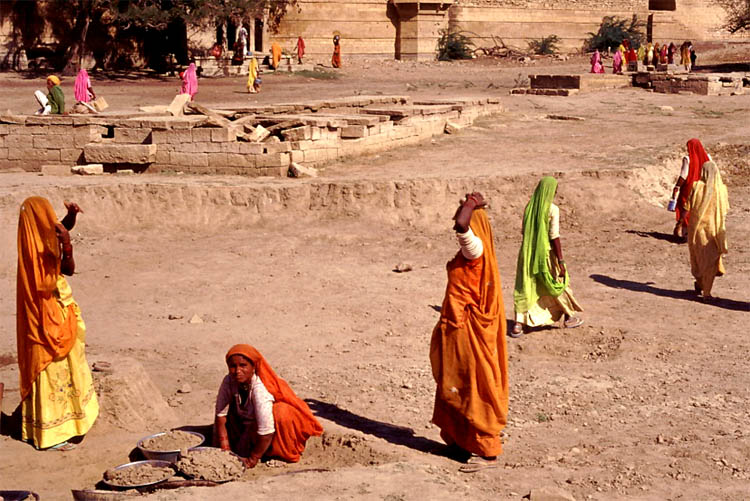
| Construction women again
|
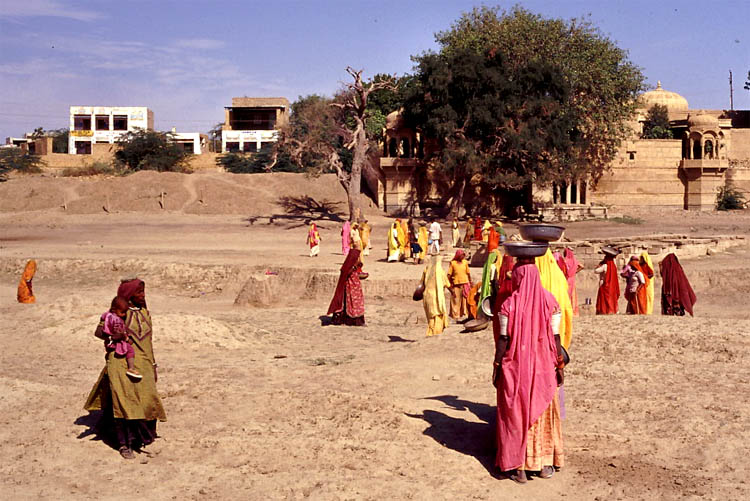
| Where are the men?
|
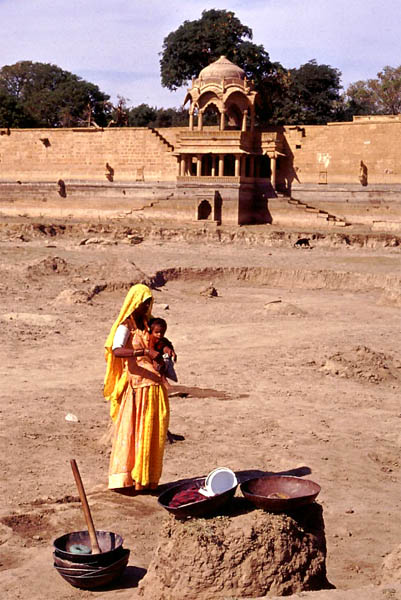
| No motherhood leave
|
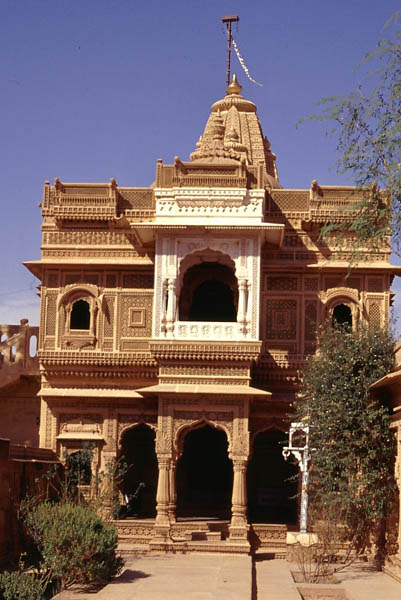
| but in god believe
|
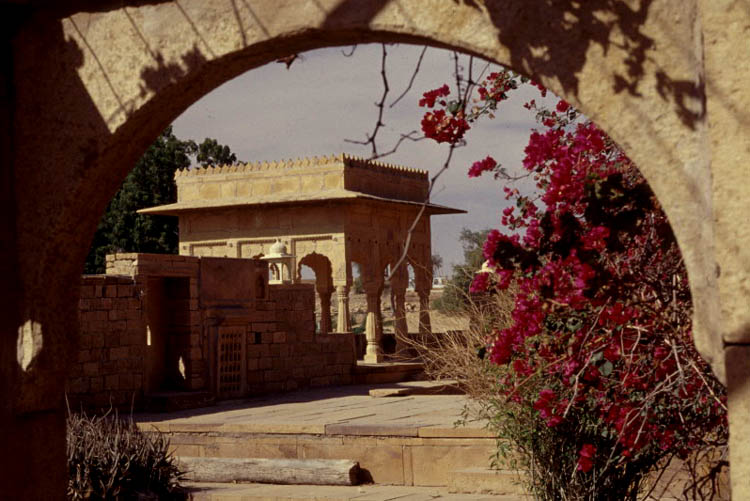
| and pray in a Jain temple
|
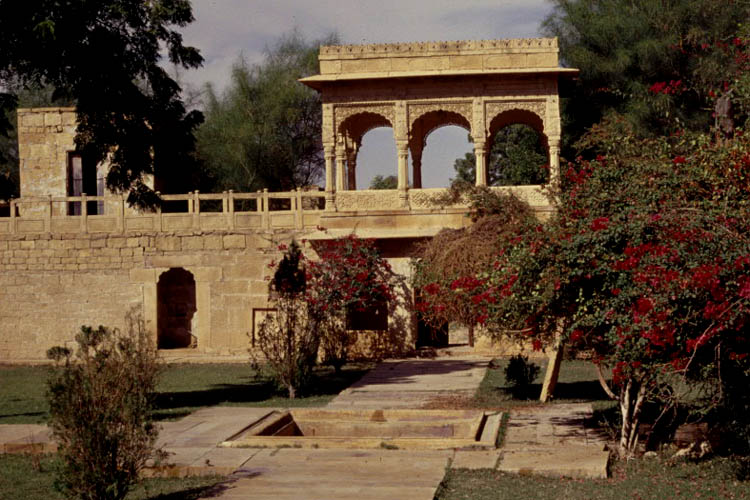
| which looks like a waterpalace
|
Now we passed through several villages and we stopped at a couple of them before hitting the real desert dunes. What we noticed was how clean the houses, some nicely ornamented, and court yards are kept. This was usually not the case of what I have seen in the rest of Rajastan. I suppose it is not that easy to clean a house made of mud and straw and the court yards all sand. Also the people were very friendly and it seemed that the family is highly valued and the social structure is still intact. The fathers and mothers proudly showed me their homes and introduced their children to us.
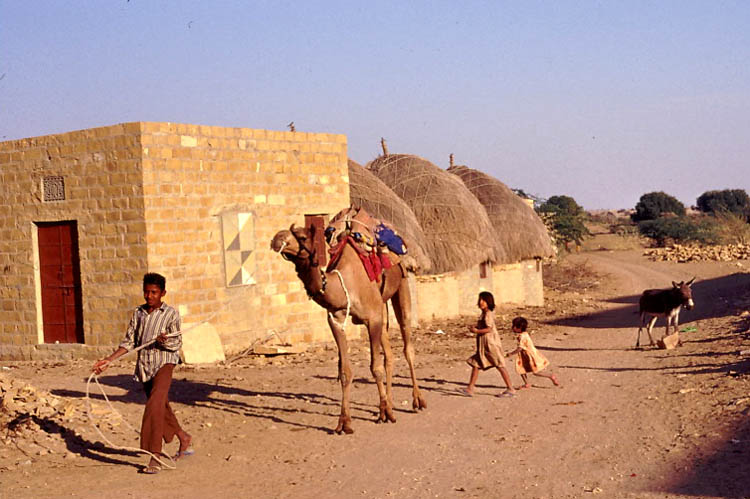
| Children taking care of the camel
|

| Village hut with a man making siesta
|
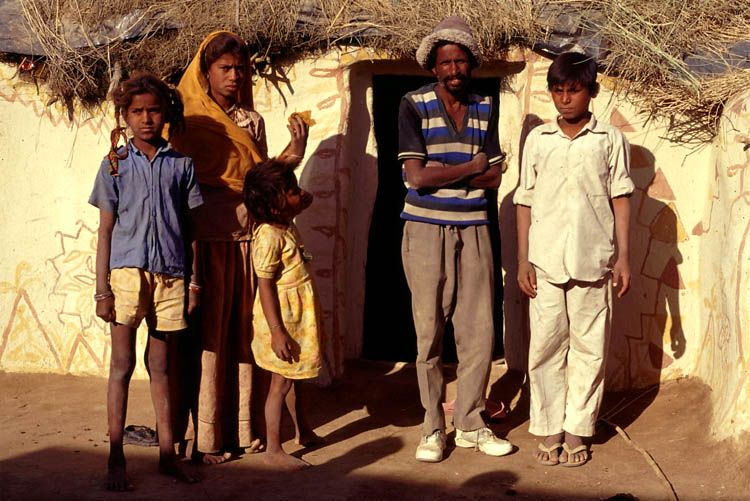
| Proud father with his family
|
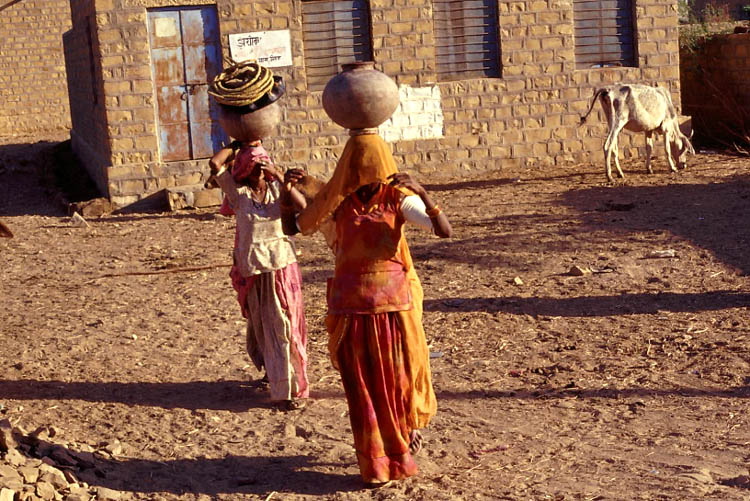
| These women are a little shy
|
The last village Khuri was just 2 km before the desert dunes. We were surprised not to find any other tourists around (yet?), not to mention the souvenir shops and pan cake restaurants (Manfred' s favorite). It really was very tranquil and relaxing strolling around and being greeted by friendly people. We kindly asked before we took a photo of them. However some of the women were very shy though, and did not want her face to be photographed (they were just superstitious and thought that we would spiritually steal something from them).
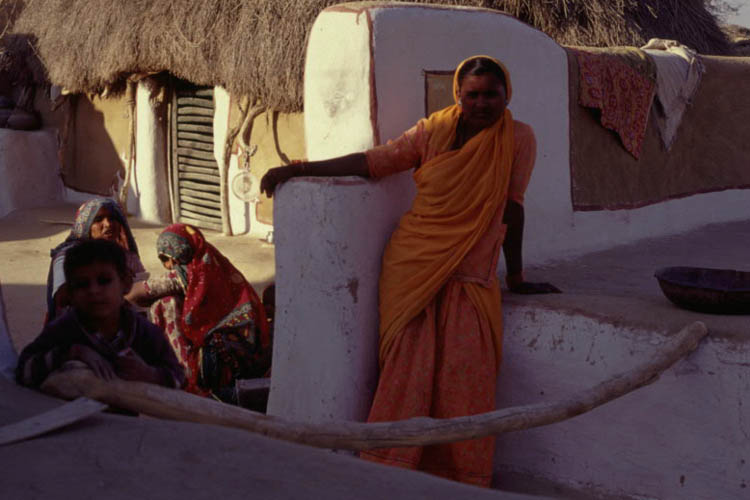
| These woman are not that shy
|
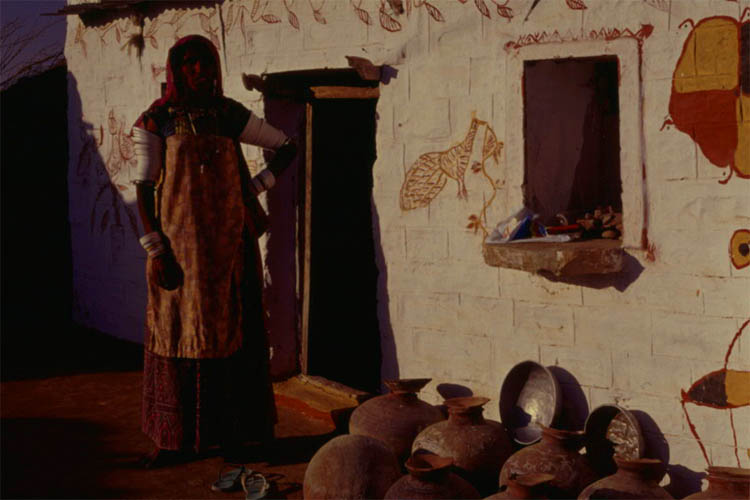
| but proud of their houses
|
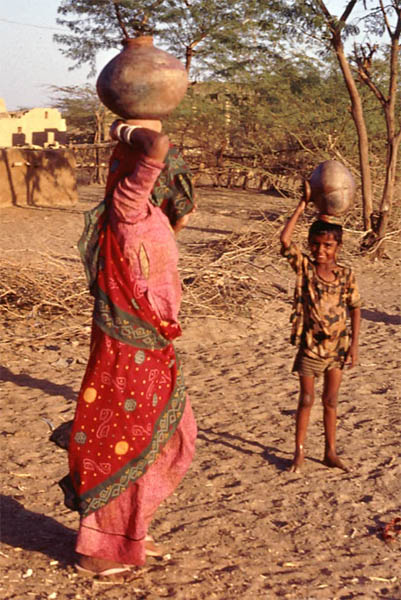
| The wife can carry water (with a little help from her son)
|
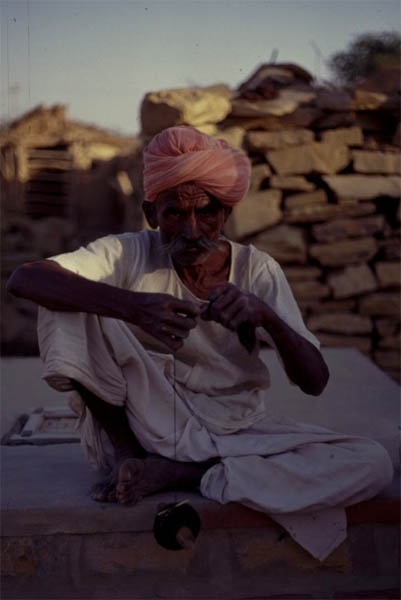
| The husbands can better spin yarn
|
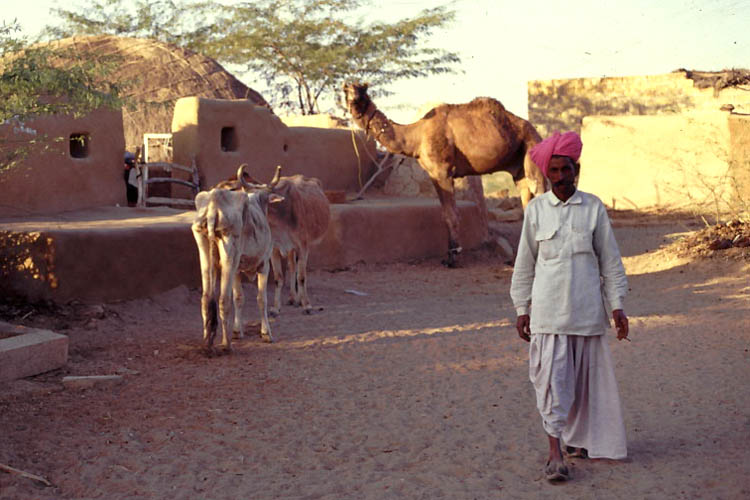
| If you own camels you are wealthy
|
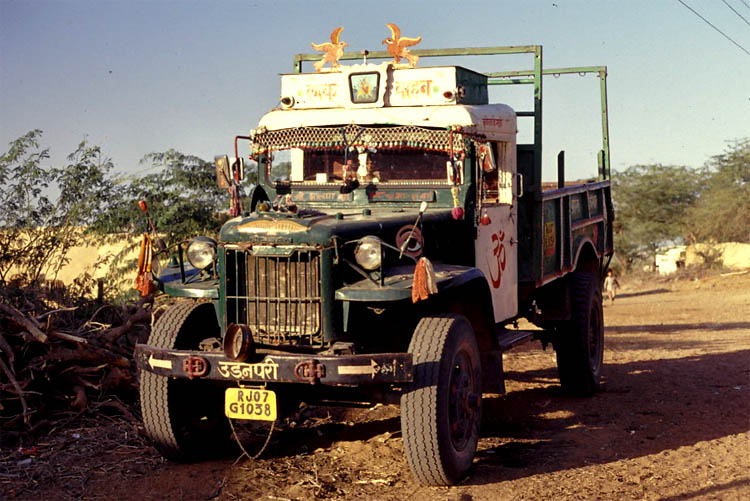
| If owning a truck you are rich
|
We could have joined a camel safari for two days and more, but we didn't want to sleep under the sky in the cold - and it can get very cold at night. In addition, riding a camel for days is not very comfortable (I experienced it again during the Camel Research Center visit). If you should join one then carefully choose the operator and where you are heading. We for example passed with our jeep many camel riding tourists on the same sealed road. If you think a camel safari is a must, I suggest that you take a bus to Khuri, stay there one night and hire a camel with rider for a whole day.

| Finally up the dunes, what a feeling
|
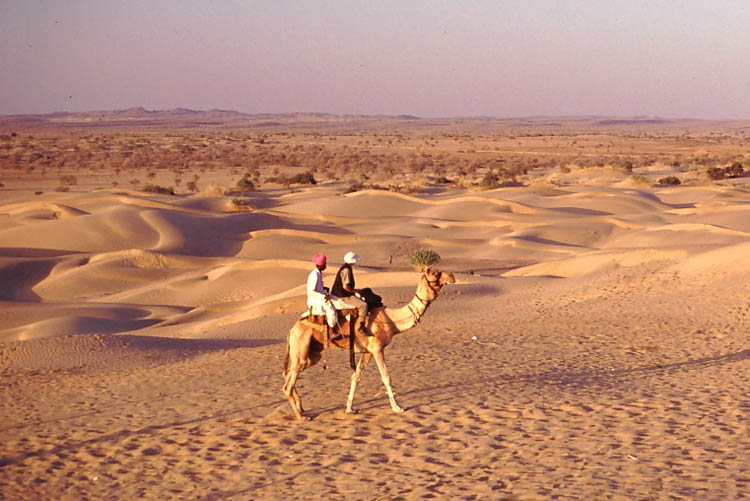
| riding a camel like in the old days
|
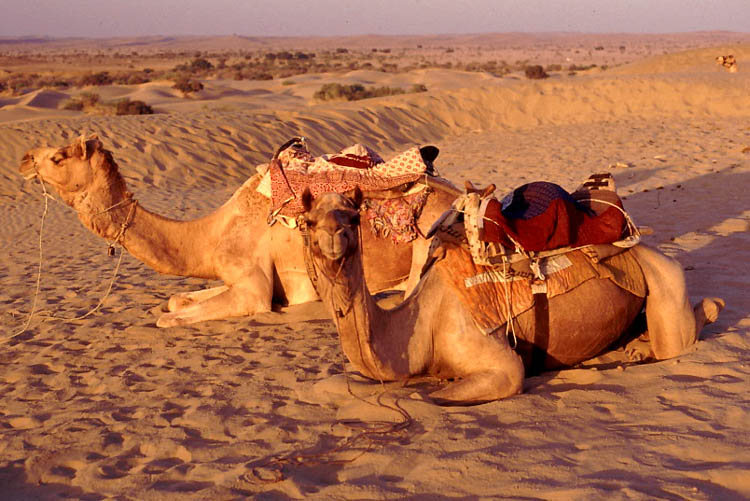
| Camels waiting for their riders
|
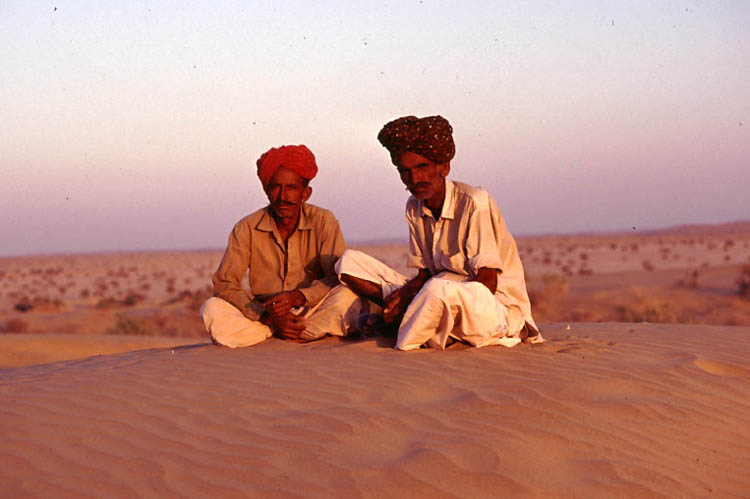
| Camel riders waiting for the sun set
|
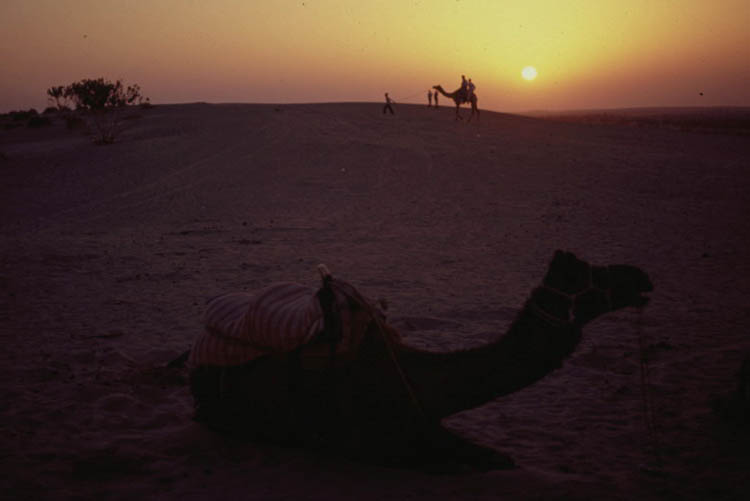
| The sun set approaching
|
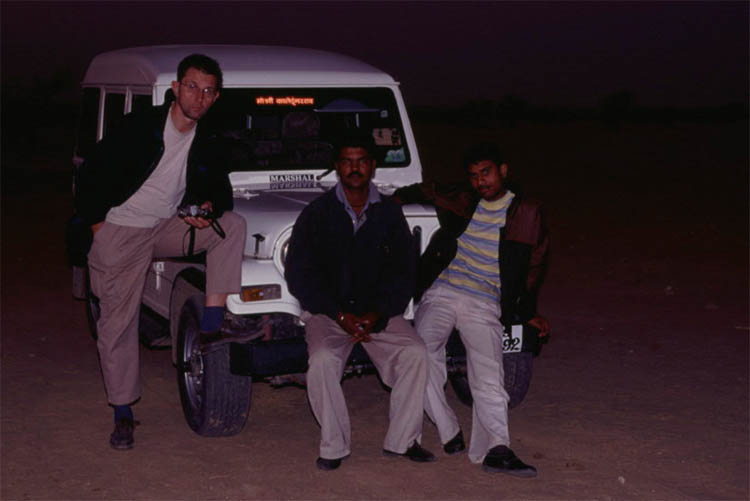
| Sun is gone, so time to head back
|
After our "safari" we had a farewell dinner in a rooftop restaurant. Since the Paradise did not have a full restaurant service, so the first choice was a few meters away: the Refreshing Point Rooftop Restaurant overlooking the Main Square. It offered an unbelievable variety of dishes, from Indian via Italian and Greek to Chinese. I even believe they also cooked kosher for some travelers we met there from Israel. And for German bread and pastries there was a German Bakery on the ground floor same building.
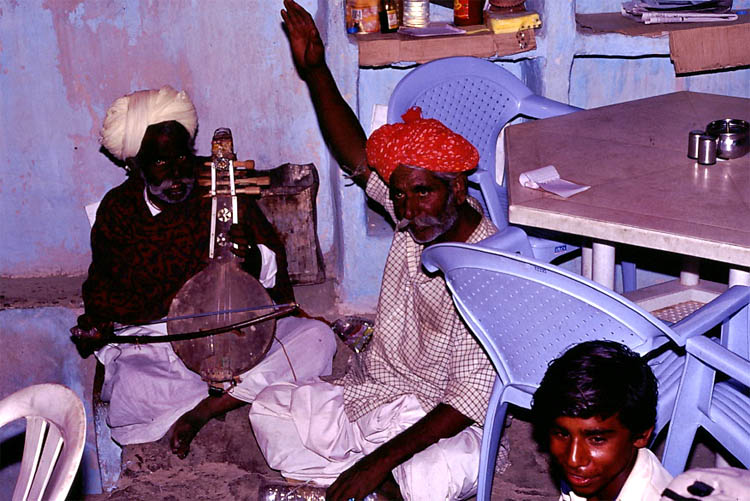
| Farewell dinner with life music in the Refreshing Point
|
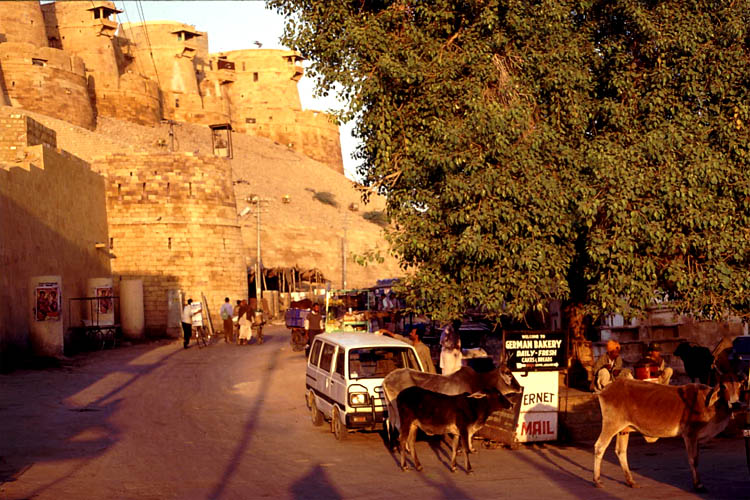
| Next day: in the morning: Good Bye Jaisalmer
|
A last word to my Ayurvedic treatment. The Ayurveda Hub and & Research Institute offer massages and herbal healing beside the full day purification program. I have decided for the latter. Manfred opted for more sightseeing in the meantime. I should have done the same, because that treatment was more stress than relaxation especially after the oily eye treatment and the colon cleansing done by a female nurse, who was coughing and let her nose drip drops on my body while she was handling me with both of her hands. The equipment did not look very sanitary and antiseptic either. Ok, I survived but was fighting the contagious cough until the real outbreak by the time I reached Delhi.
Jodhpur
Next day after a 5 hour bus ride we arrived in another fantastic city with an even more impressive fort: Jodhpur. It is the next largest city in Rajastan after Jaipur. Founded in 1459 it was the capital of the Rathore Kingdom. The old city walls are 10 km long but the most dominating structure is the massive fort: Meheranghar. Also here we wanted to stay within the walls, not necessarily in the fort (which was not possible anyway), but within the city wall. The best place we already considered and stayed after inspection was the
Yogi Hotel
Jodhpur
Tel.: 643436
Email:yogiguesthouse@hotmail.com
|
with a rooftop restaurant and clean rooms. The rate was around 150 rupees (3.50 Euro). But again: the most important thing was its location, location, location, though not within the fort but right at the base of the fort's wall. It was a nice walk along and between the wall and the city slowly ascending to the road which directly leads to the first gate.
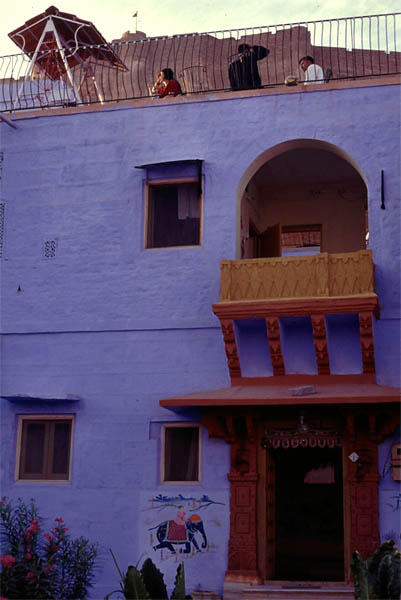
| This is our Yogi Hotel
|

| Just right under the majestic fort
|
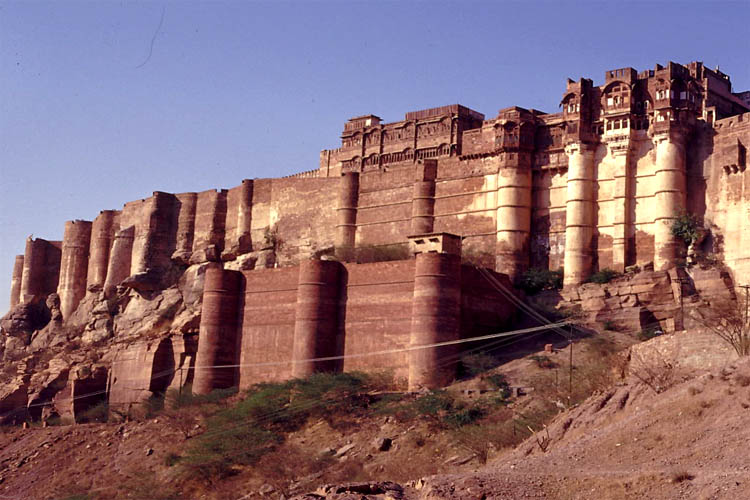
| Imposing walls
|
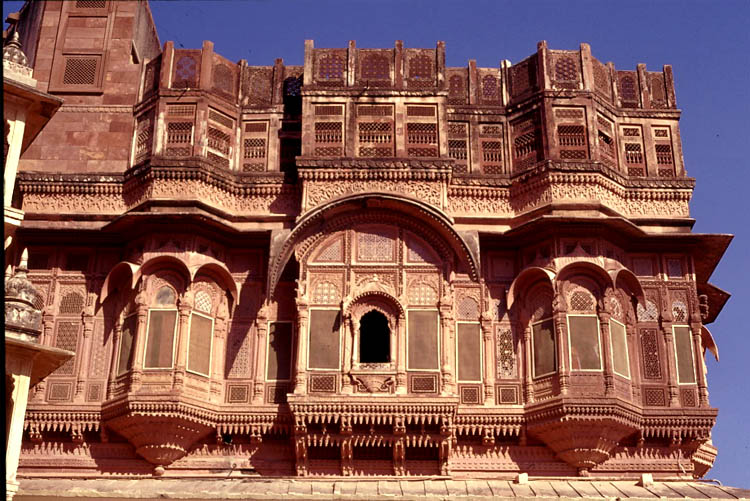
| Fantastic buildings
|
After buying the entrance tickets we ascended further up the serpentine road and passing through 6 more gates. Finally inside the fort there are several courtyards and palaces. The palace apartments have names like Pearl-, Flower- and Pleasure Palace. It did not tell which kind of pleasure the maharaja pursued in there.

| It will not fall but stand for another 500 years?
|
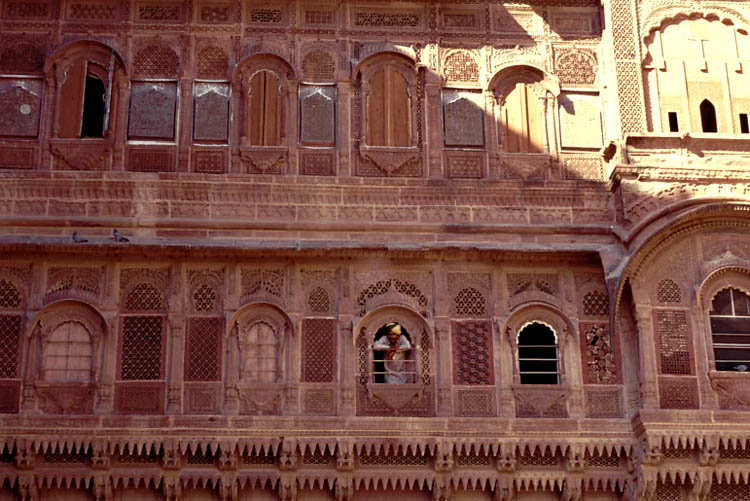
| also looks nice from out the window
|
But today the palace houses one of the most interesting collection of artefacts in Rajastan. The armory displayed an assortment of deadly weapons, which demonstrates how cruelly they must have been used to inflict the most painful wounds to the enemy. Battles have been fought with Jaipur, Bikaner and Jaisalmer. Also cruel was the sati (the self immolation) of the Maharaja Man Singh's widows, who burned themselves to death in the funeral fire of their beloved husband. The handprints of those 18 wives are also on display at the gate. There could have been more: another maharaja of the same dynasty had 30 wives (beside numerous concubines).
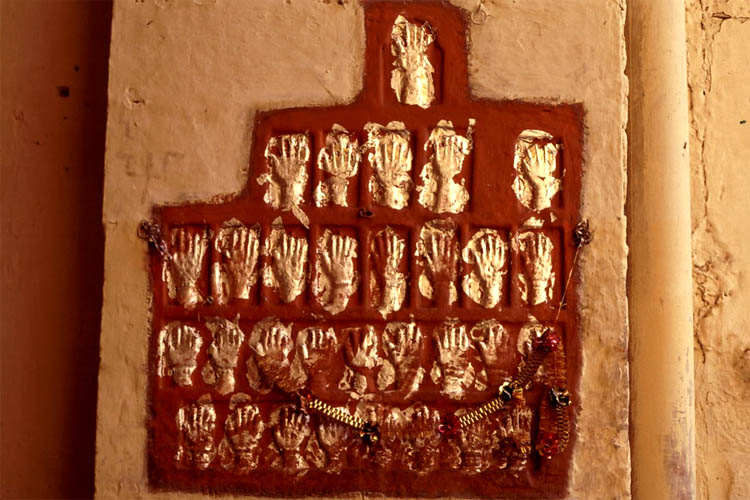
| Handprints of wives who threw themselves into the funeral pyre
|
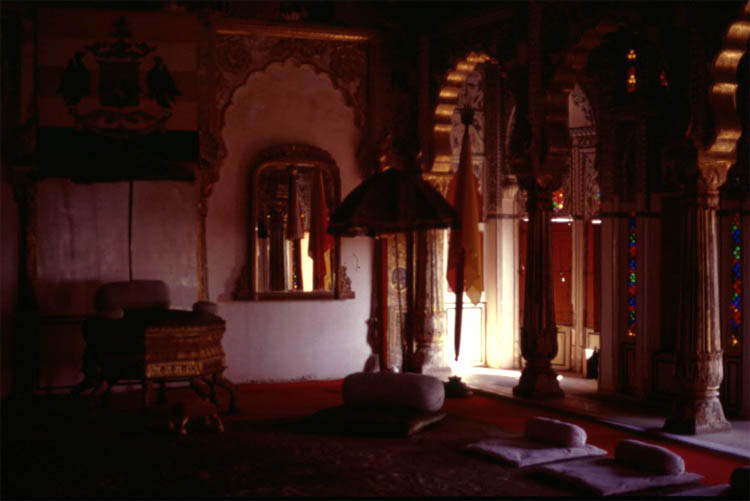
| They had a short but good life before in the palace
|
After the exhausting museum visit a stop at the Cafe Mehran (just next to the museum entrance) is recommended. It shows nice paintings depicting maharaja's life. After that we even went further up until we could look over the ramparts down onto the blue town. What a magnificent view. All Brahmin's houses are painted blue. Actually I didn't know of so many Brahmins (they are the highest caste in India). One Bramin told me once, we should be happy to be born as a human being, and happier if born as a man, and much more happier if born as a Bramin.
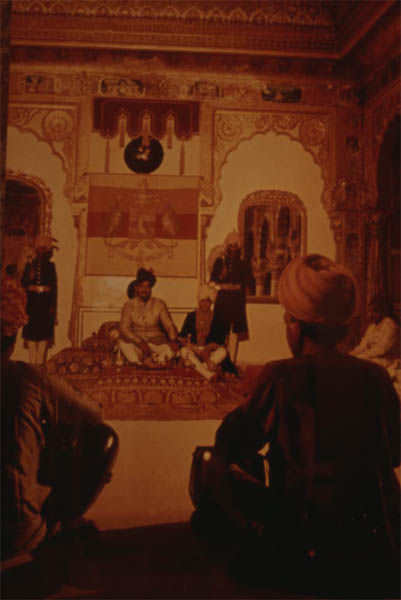
| The maharaja probably had even a better and longer life
|

| This is the view into the blue (city of Jodhpur)
|
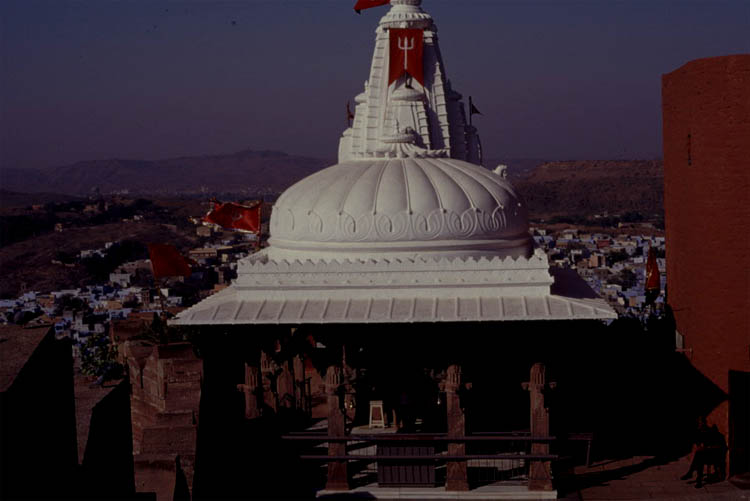
| On the top: Chamunda Devi Temple
|

| And cannons for the defense
|
On the same way down back to town we passed a man in front of a house. We just said hello and he asked of what nationality we are. He seemed to be happy with our answer and invited us into his house. We had small talk and drank tea in his living room (made sure that all cups are filled from the same kettle).
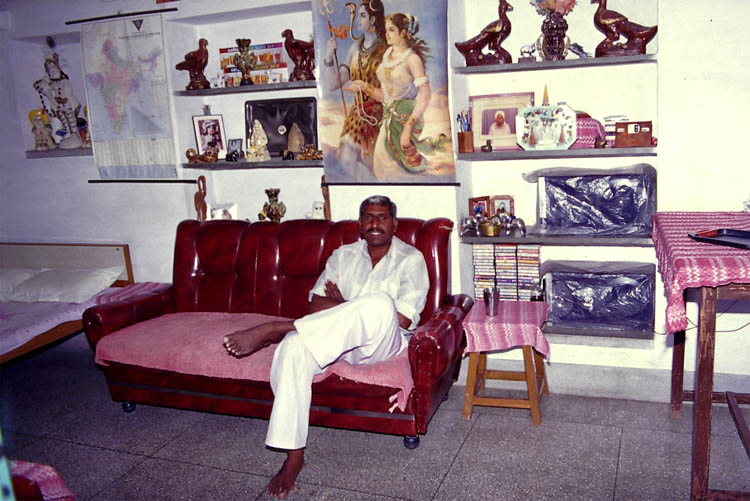
| Invitation to a tea for three
|
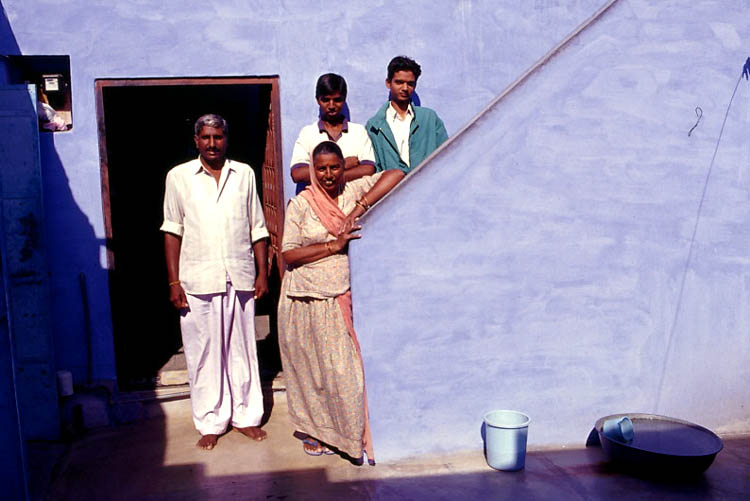
| and a proud demonstration of his family
|
Back in town or better bustling old city. The best area to stroll around was of course between the bazaars in the small alleys of the Sagar Market, of which the middle is dominated by the Clock Tower.
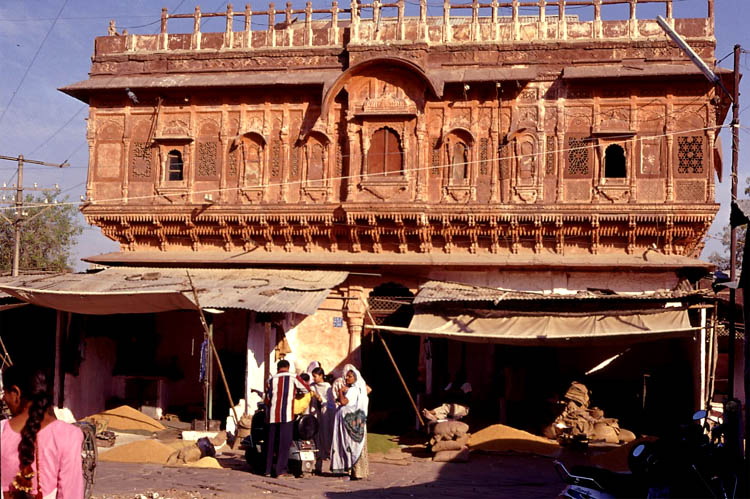
| Warehouse
|
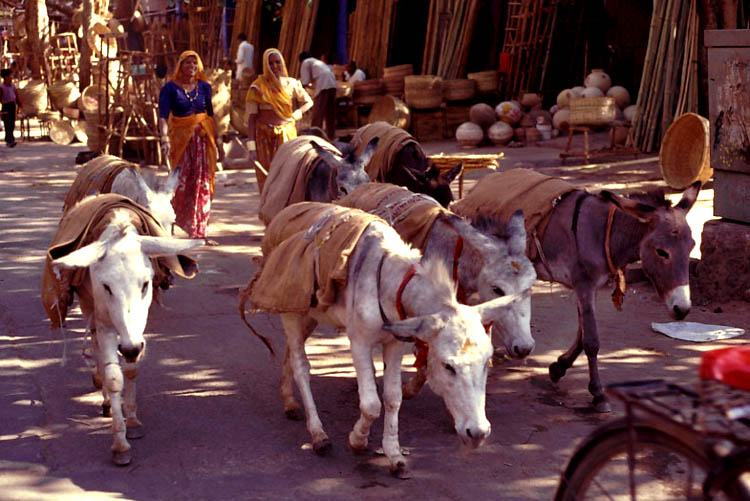
| Donkeys
|
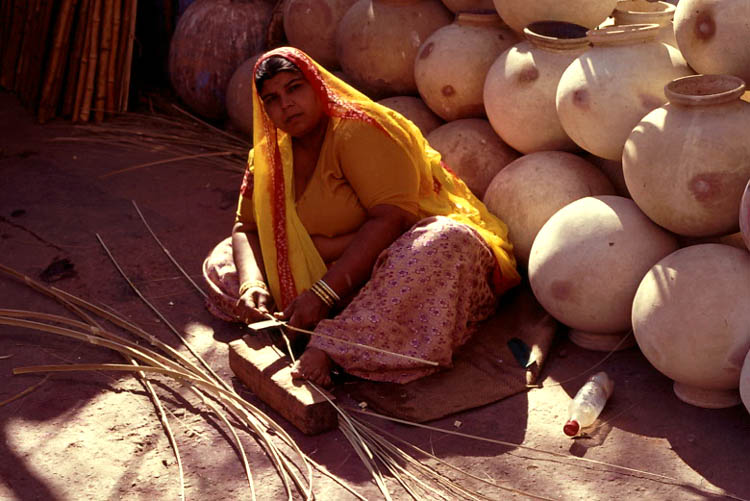
| Busy woman
|
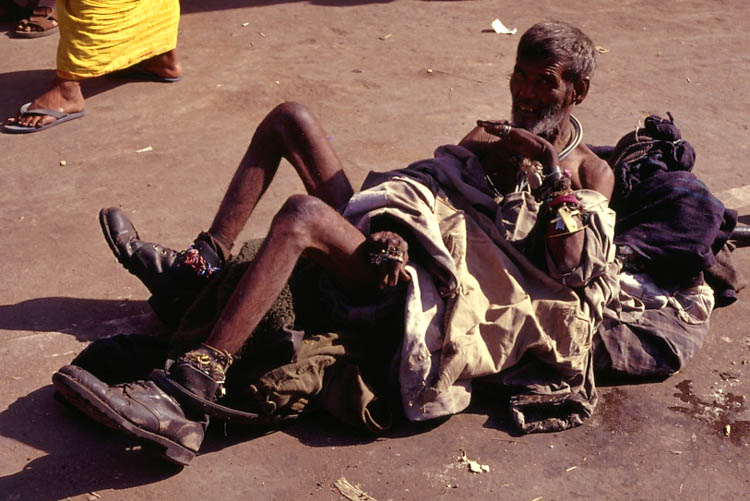
| Lazy old man
|
Wandering around all day makes hungry. We have also earned some rest too. Even if it was sitting on a plastic stool at the omelette stall waiting to be served the most famous pan cakes in Jodhpur. The number of eggs piled up proves the turnover rate of supposedly 1000 eggs a day. You find that stall behind the gate to the north of the square with the Clock Tower. This is a gate within the old town. The other gates below are part of the old city wall, i.e. located between the old and new town.
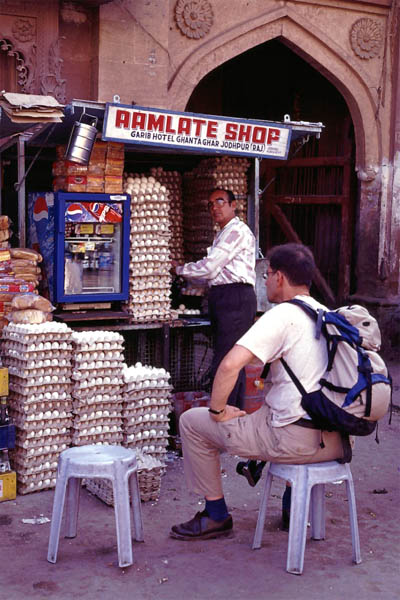
| Manfred is waiting for his pancake
|
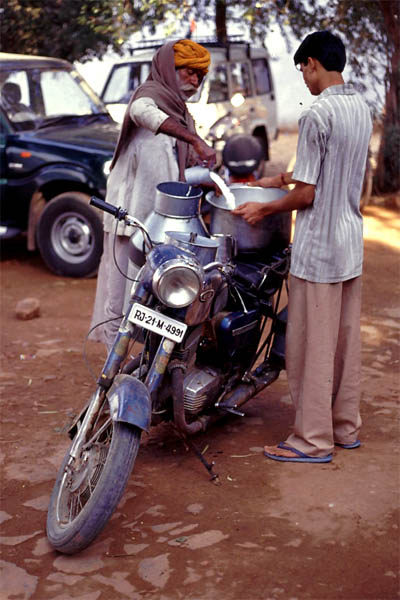
| He did not dare to drink fresh milk with it, though
|
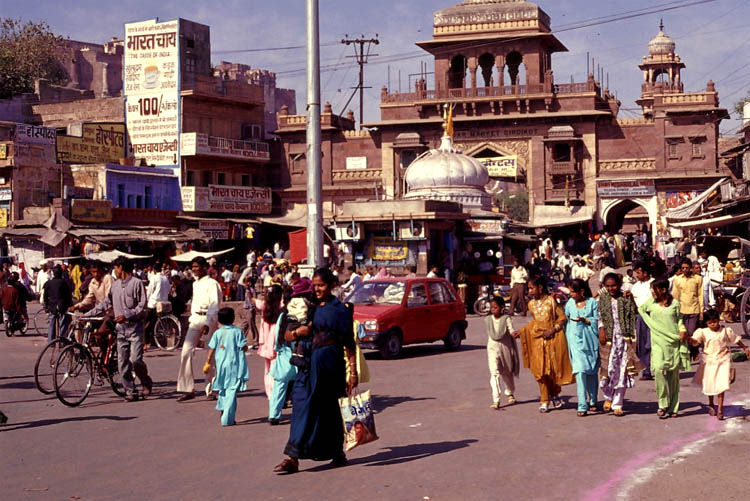
| New town with one of the gates to the old town
|
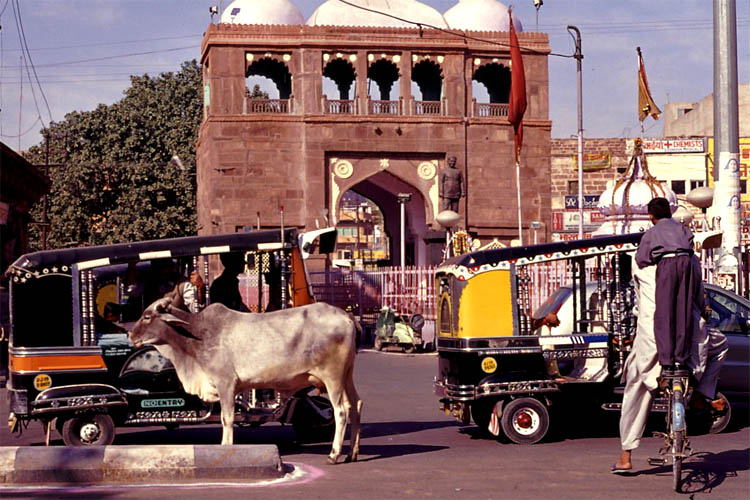
| Another gate with new city traffic in front with the obligatory cow
|
There would have been a lot more to see. The Tourist Reception Center also conducts daily tours. One interesting thing would also have been the visit of several villages around Jodhpur, called the village safaris. Unfortunately we had to leave this fantastic city in order not to miss the next one on our planned itinerary. Next day, after about 7 hours bus ride we arrived in the most romantic city of Rajastan: Udaipur.
Udaipur
There are really enough guest houses to chose from. Preferred traveler area is the Lal Ghat area, with small streets. And the prices are low because of a lot of competition. Try to get one with a rooftop restaurant facing the lake and even better: a room with a view to the lake, Just to name two: Lalghat Guesthouse or the Hotel Gangaur Palace with prices in the 250 to 350 rupees range (5.50 - 8.00 Euro). I really don't remember the name of the guesthouse we stayed in, but you can find it if you look for the same view we had from our breakfast table.
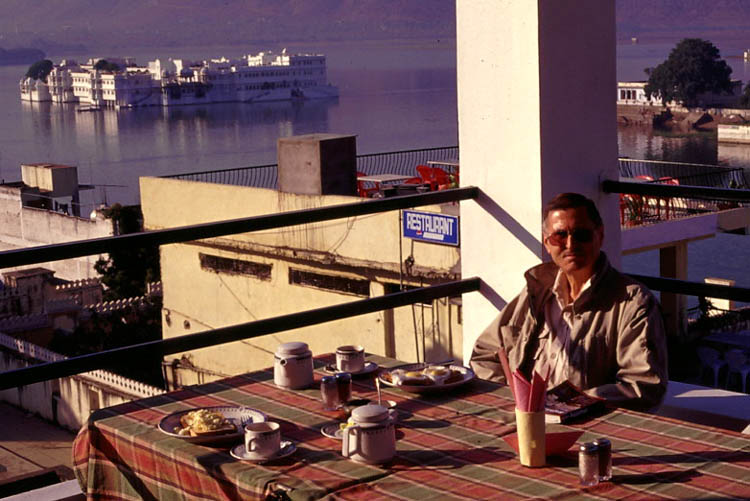
| Breakfast on the roof with a view to the Udaipur Lake Palace
|
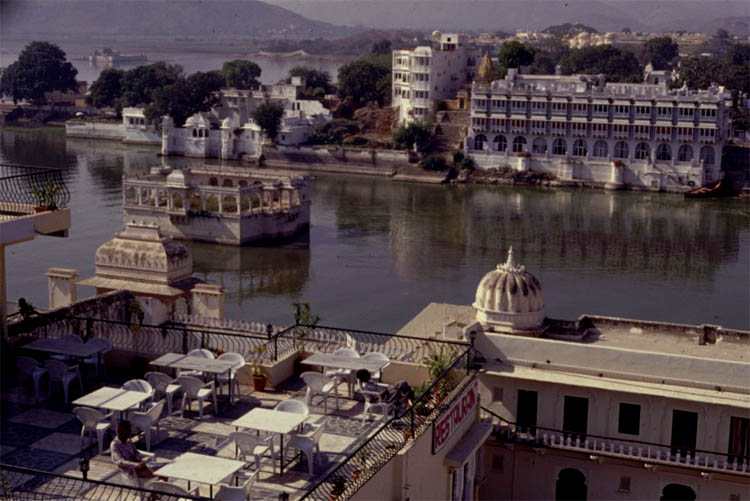
| Looking down on more roof top restaurants
|
The most famous landmark in Udaipur is the Lake Palace in the Lake Pichola, once a summer palace and converted to a hotel in 1960. It is one of the most exotic hotels, but unfortunately no visitors are allowed, only for lunch and dinner (with reservation only). Or you pay the exorbitant room rate for an overnight stay. James Bond could afford it, because this palace (and two others) were the location where the James Bond movie "Octopussy" was made.
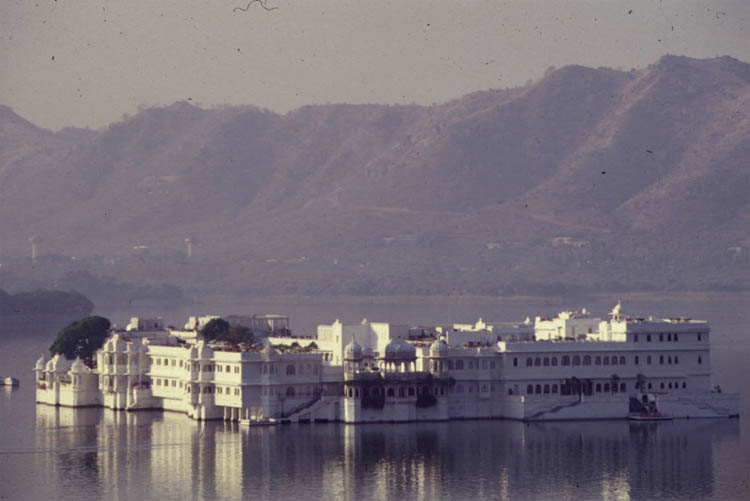
| Palace at sun rise
|

| Palace at sun set
|
The Lake Palace may be a jewel and the houses bordering the lake are white clean but the lake is already polluted. But this does not hinder the women to wash their laundry.

| Will the laundry get as white and clean
|
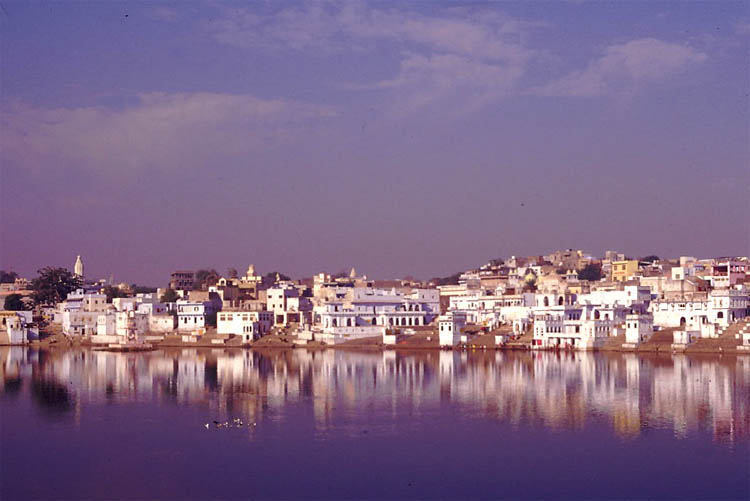
| as white and clean as the houses opposite
|
There are organized city tours starting at the RTDC Hotel. But I hired a rickshaw for 200 rupees (4.50 Euro) the whole day to get to all the same places on my own speed and this time by myself, because Manfred did not feel well and stayed in town. First I passed by the lake Fateh Sagar with a garden island in the middle called Nehru Park. However, after several years of drought there was not enough water in it to call it a lake, so you could have walked there, although getting wet feet. Some men did not care and even took a bath in the dirty puddle. They may have been immune of the colibacillus.
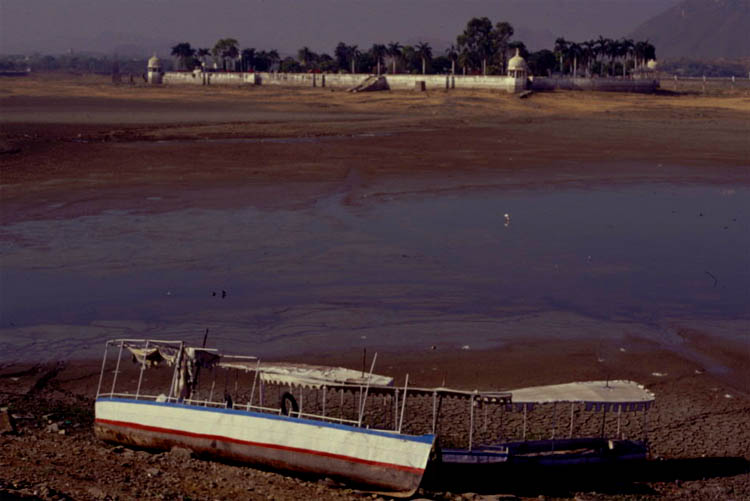
| Dried-up lake
|
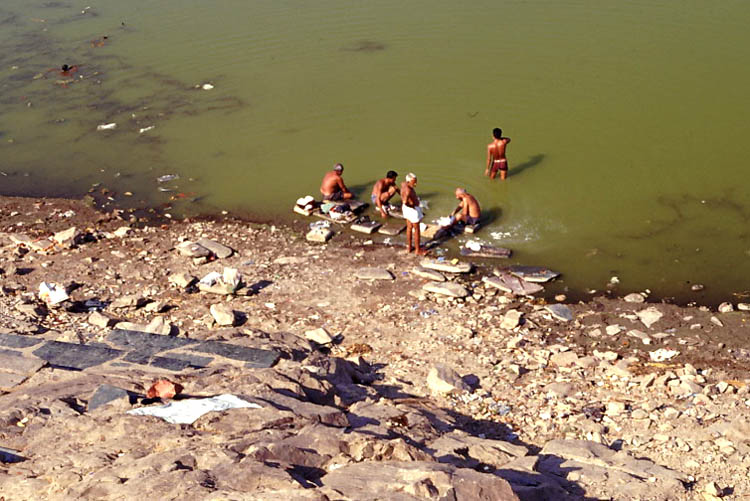
| Dirty men even take a bath in the filthy water
|
Very much in contrast was the beautiful garden close by.
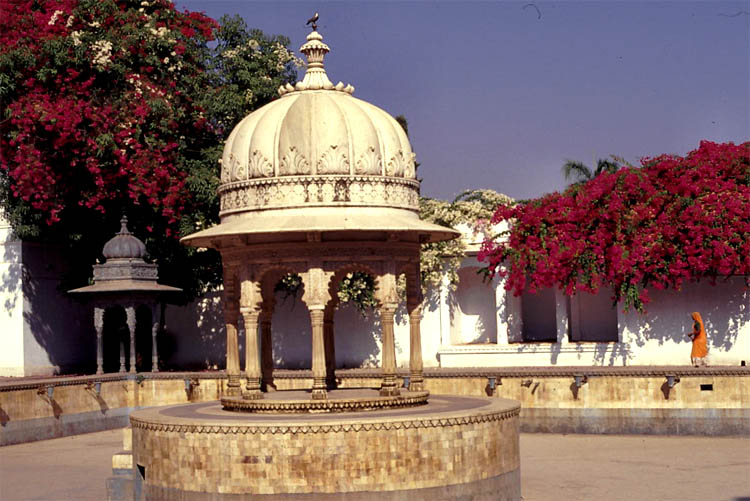
| Garden with pavilion
|

| Garden with elephant
|
Then I visited a tourist village called Shilpgram, a folk culture village with traditional houses from 4 states and with demonstrations: dancers, musicians, artisans handicraft, art sculptures, etc.
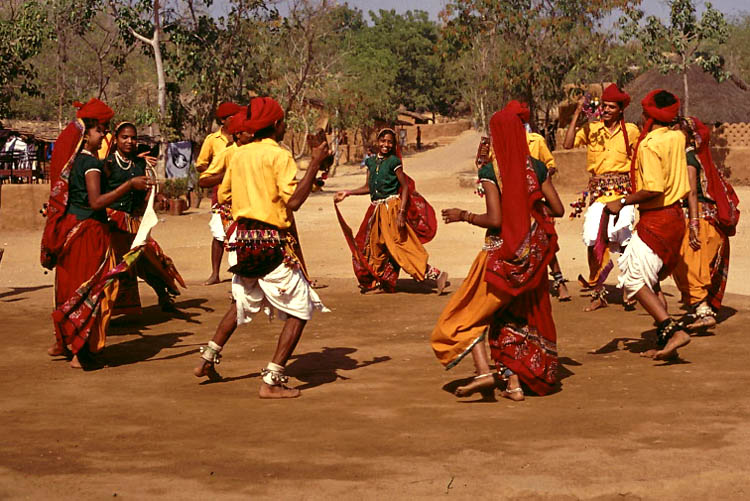
| Folk dance group
|
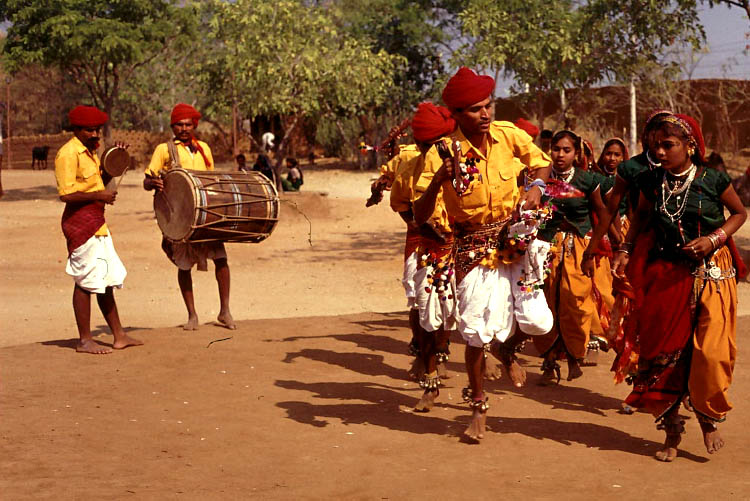
| with musicians
|
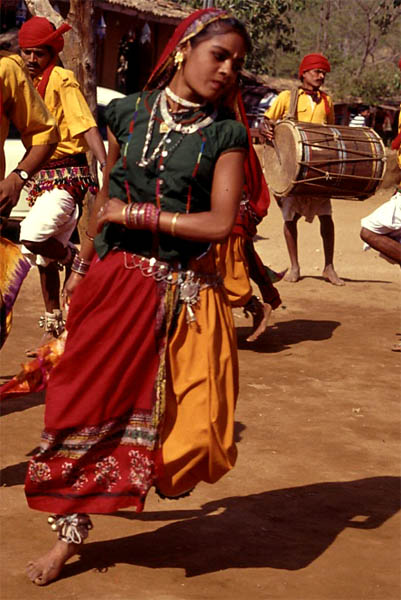
| Folk Dancing Queen
|
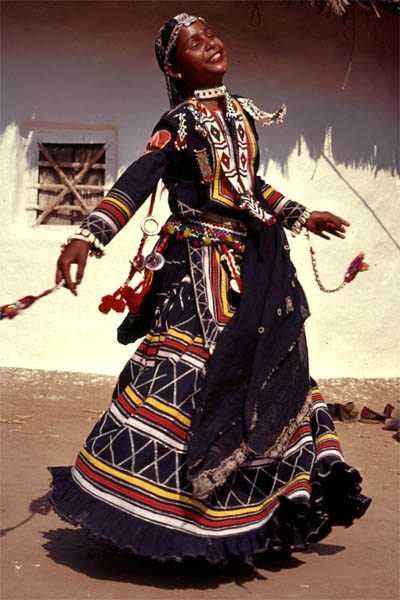
| Folk Dancing Queen of another tribe
|
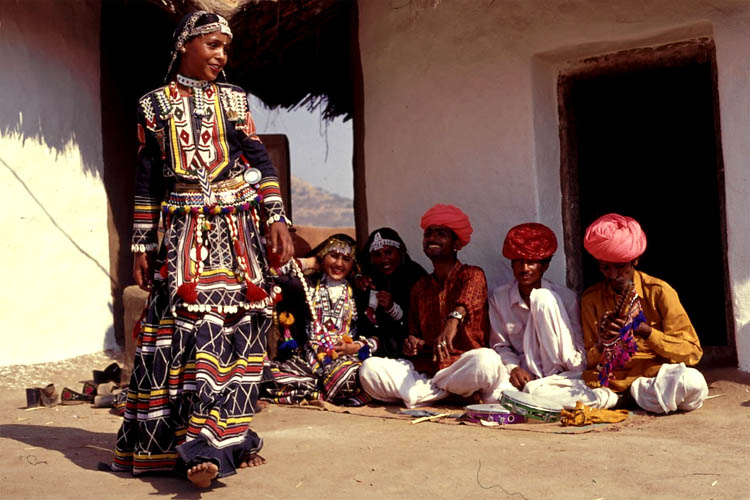
| One folk dancer with band
|

| Two folk dancers
|
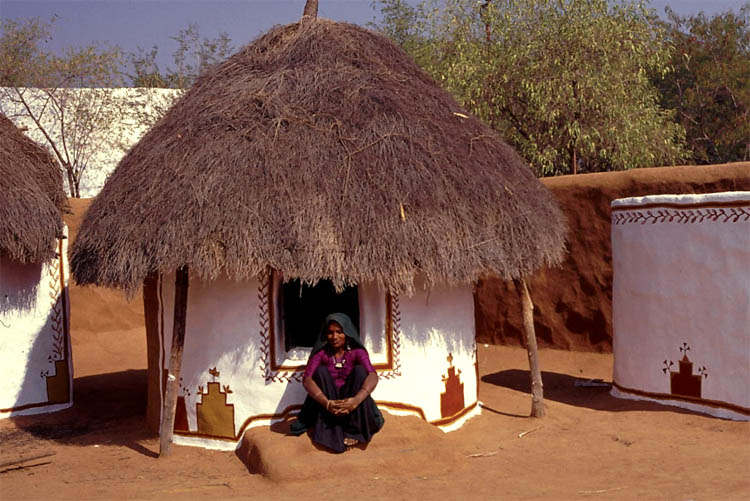
| Small hut (single?)
|
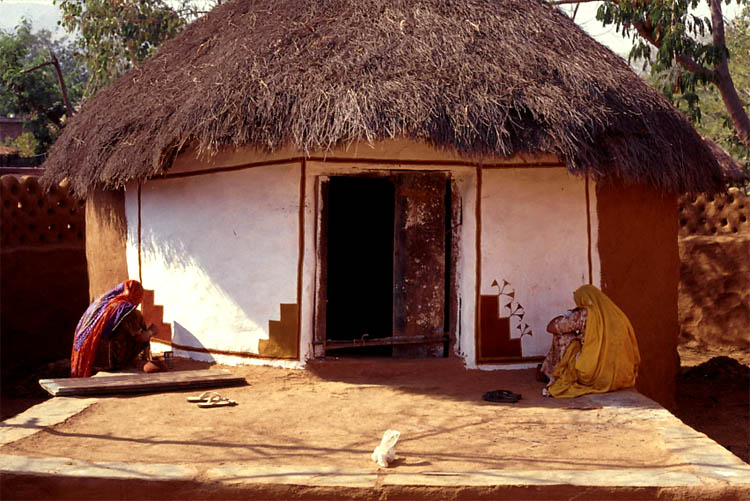
| Big Hut (double?)
|
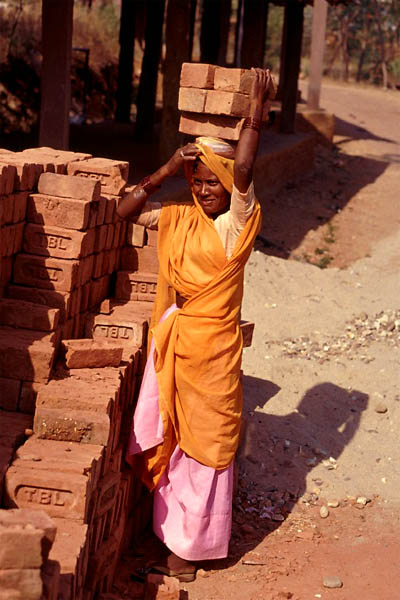
| Hard working girl, we should object
|
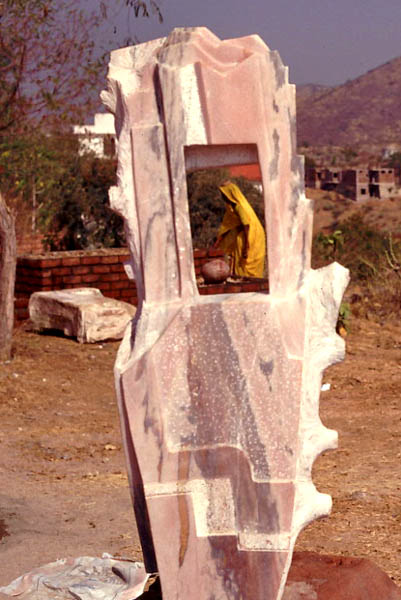
| Better posing as an Art object?
|
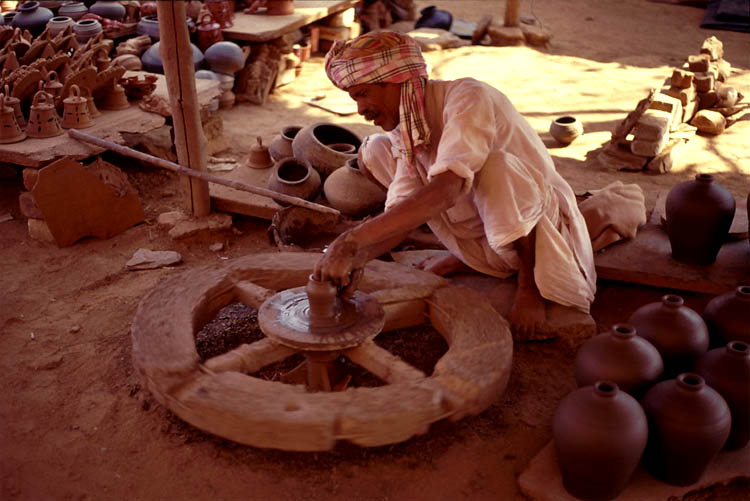
| Handicraft, old fashioned
|
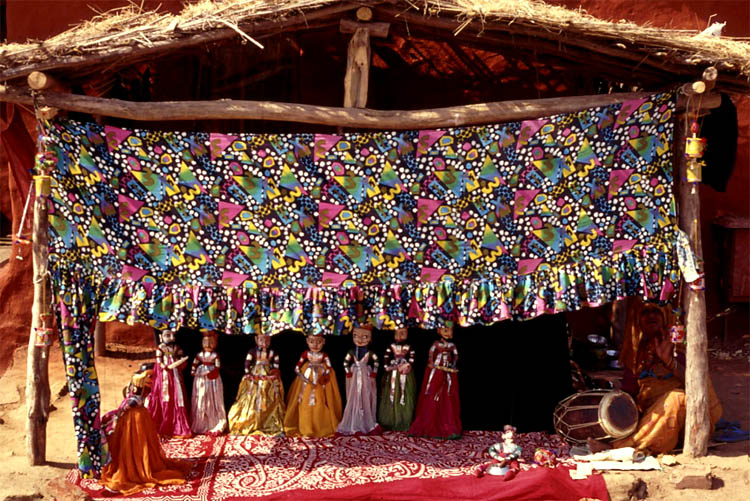
| Modern puppet theater
|
Then I continued to the Tiger lake (Badi Ka Talab), which is an artificial lake used as a water tank, but also did not contain much of it. At the side you can see the water level marks and if the highest is reached then the pavilions are under water. After that I headed to the deserted and run down Monsoon Palace high up the hill to watch the sunset.
It has a stunning view to the lake and the surrounding hills and Udaipur with the Lake Palace and the City Palace on the shore, which is the largest palace complex in Rajastan (the main parts of the palace is preserved as a museum).
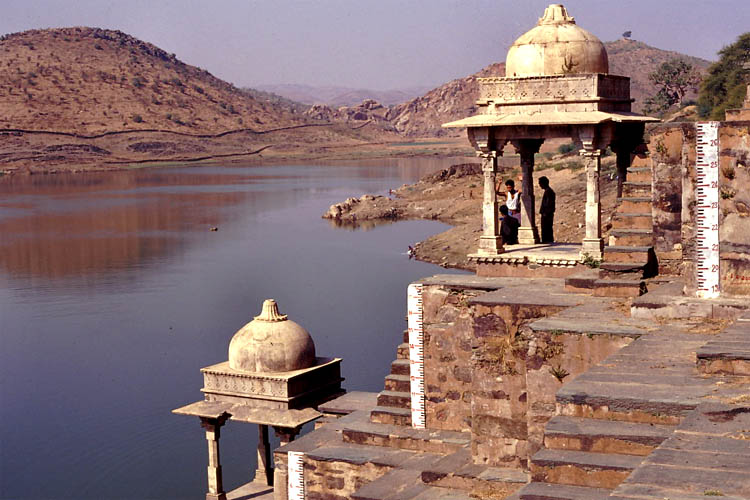
| Lake with water gauge
|
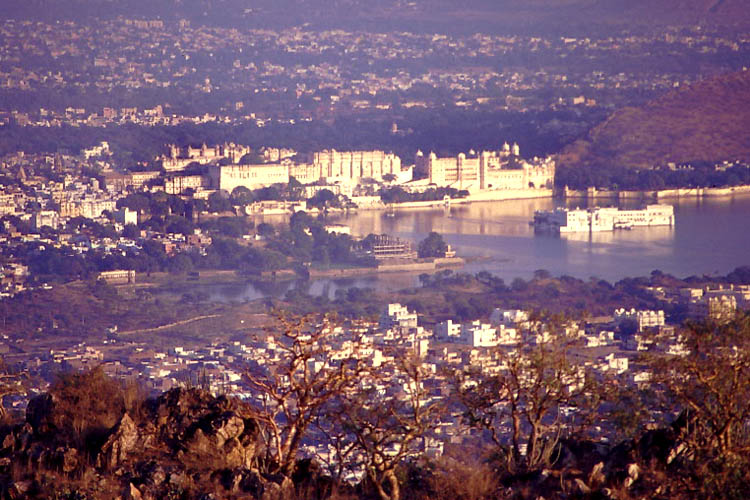
| View from Monsoon Palace
|
Pushkar
This was now the last stopover before going back to Delhi, at least for me, or continue the journey by train to Mumbay and Goa for Manfred. The bus took us first to Ajmer and after hopping on a van we arrived late afternoon in Pushkar, which is firstly an important pilgrimage center and secondly famous for ist annual camel market, which is a fair and carnival at the same time and takes place once a year, depending on the moon. In 2002 it was from Nov 11 - 20, so we just missed it
We checked late into a guesthouse in the middle of town. Next day we strolled around looking for a better hotel and found the Hotel Pushkar Palace. The rooms we looked at were not that nice, so we decided not to stay here. The garden restaurant, however, was a wonderful spot to see the lake and watch the ghats, while having a drink.
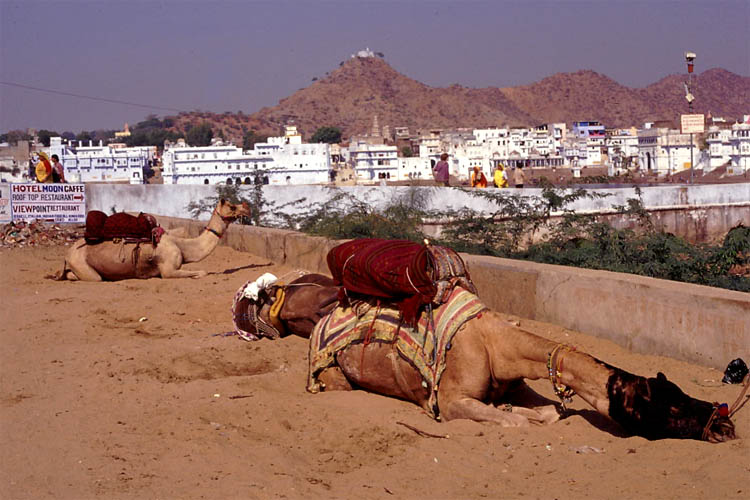
| Pushkar and camels belong together
|
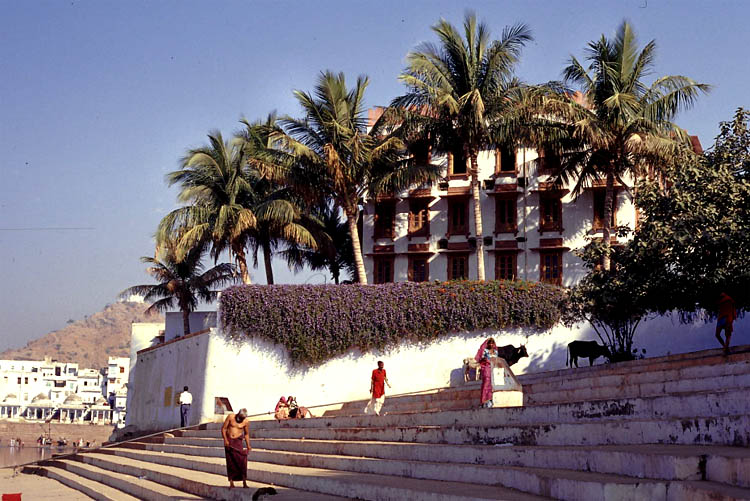
| Supposed to be the best hotel in town
|
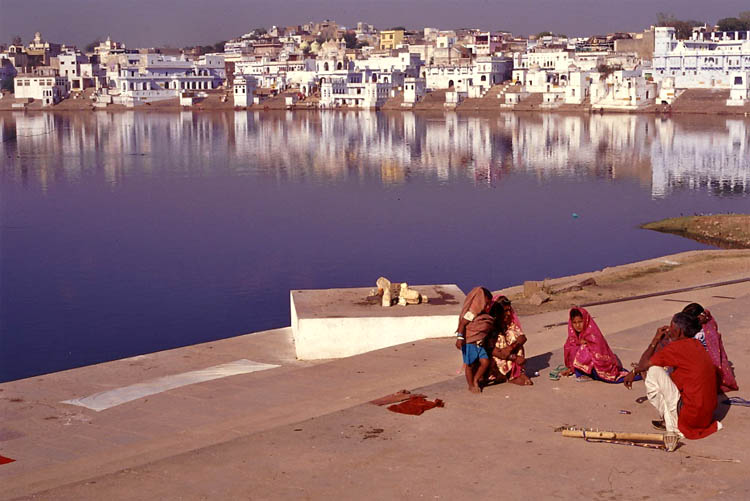
| View to the lake
|
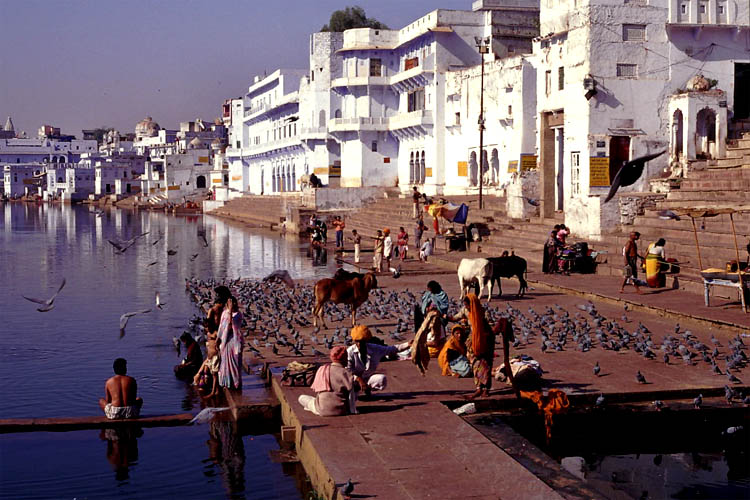
| and the ghats
|
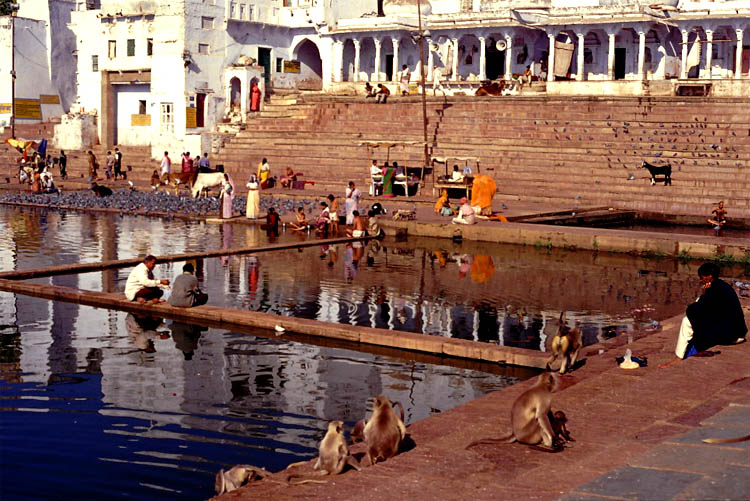
| Holy monkeys
|
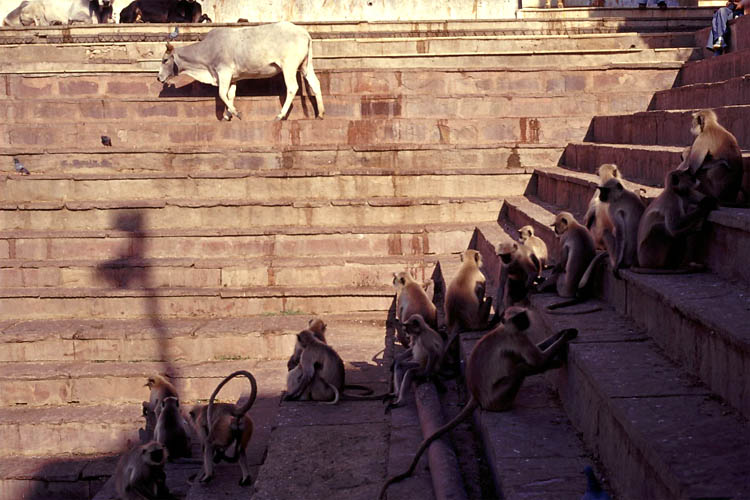
| Holy cow
|
Every Hindu should visit Pushkar and take a bath in the holy lake once in his lifetime. And some Hindu may stay there for the rest of his life, using the lake as a bathroom, kitchen and laundry place while staying in his own customs build hut right on the bank.
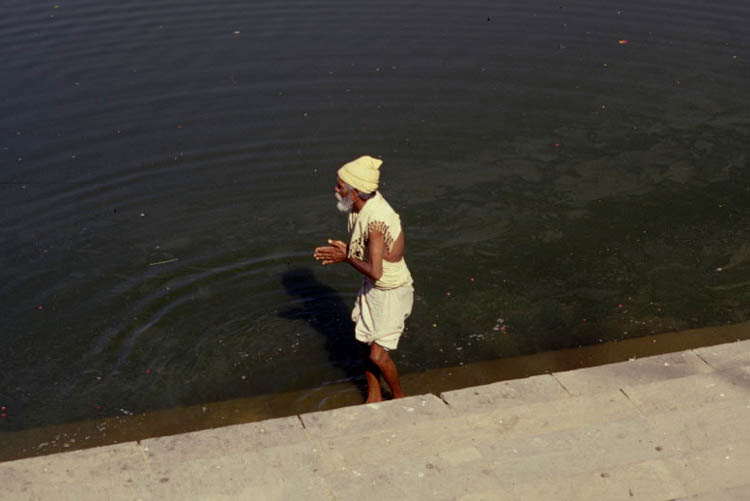
| Holy lake, holy man
|
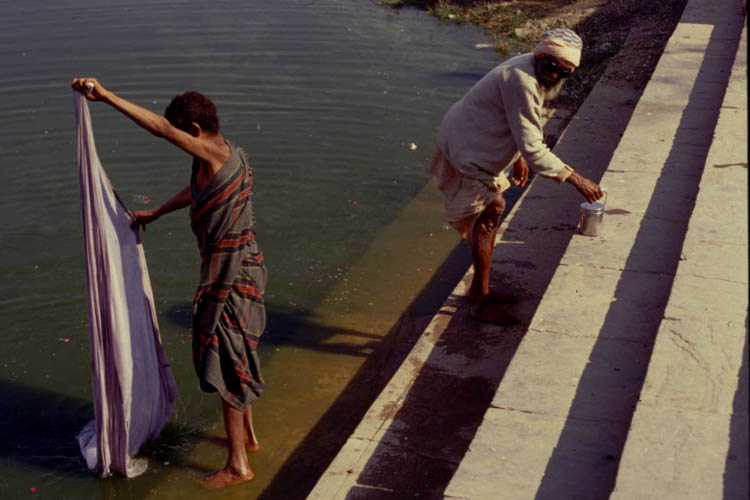
| Holy laundry, holy water
|
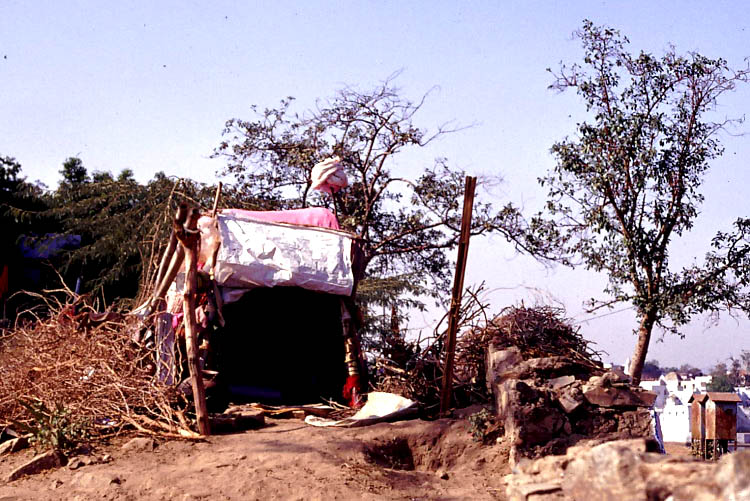
| Holy man's holy home
|
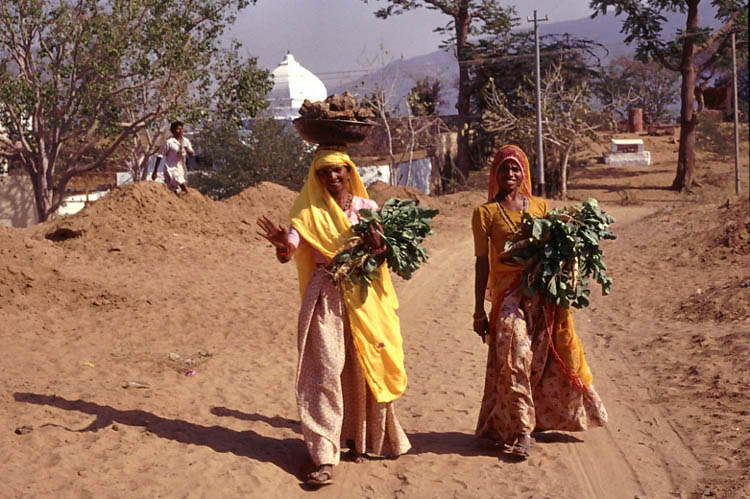
| Holy man's girl friends?
|
With 400 temples in town everything is holy. The most famous is the Brahma Temple marked by red spire. Puskkar is also last not least a major tourist spot, especially with hippy like shops selling raver gear in the main street and rooftop restaurants playing techno music. One of the rooftop restaurants is the Lake View with really a nice view over the lake, where we had a drink (while listening to techno). Since they also had guest rooms, it may also be a nice place to stay (we did not check). .
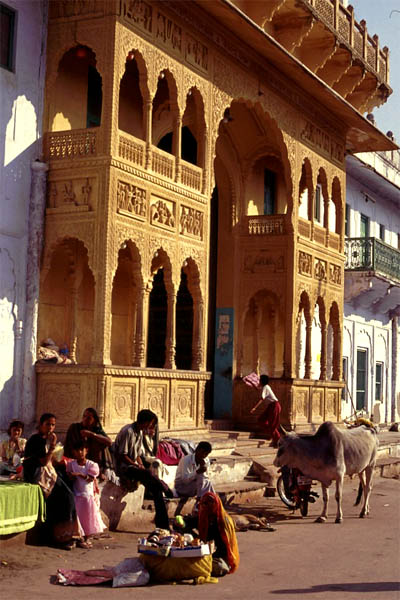
| Holy Jain temple
|
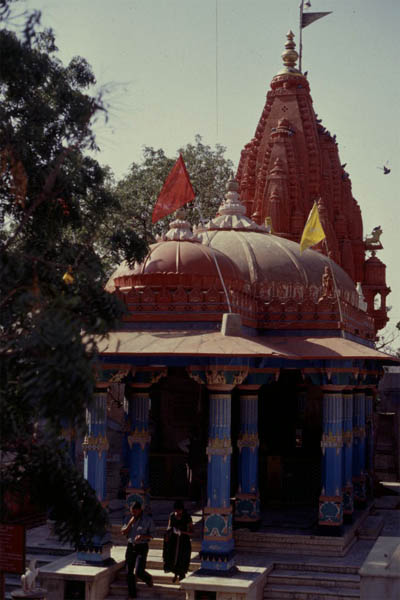
| Holy Brahma temple
|
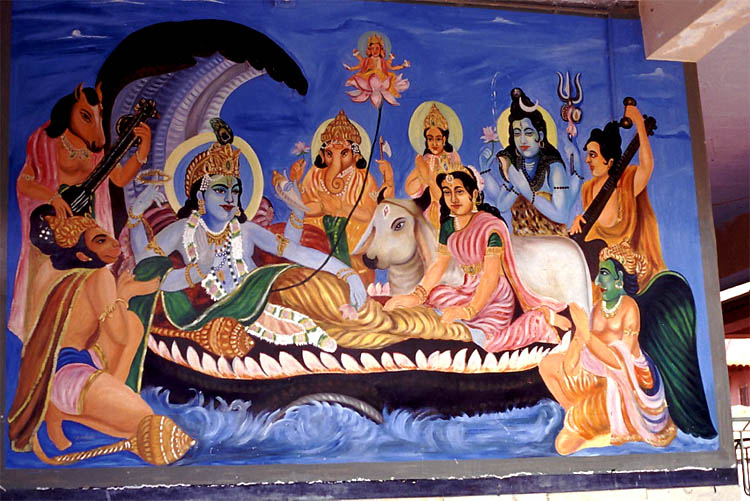
| Holy painting
|
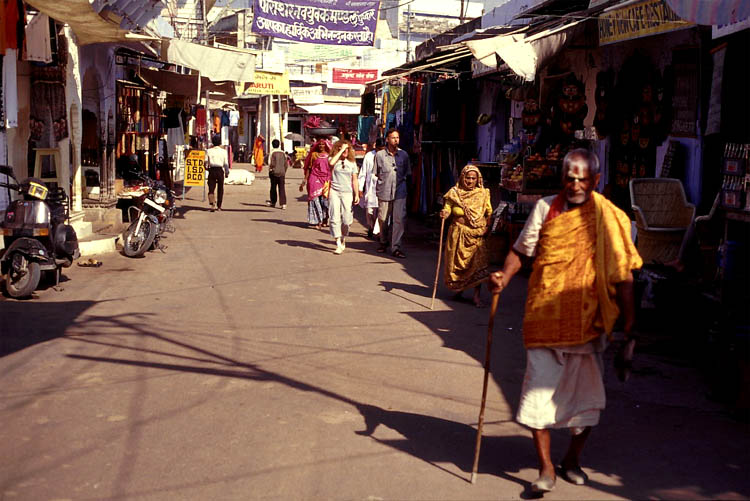
| Holy Pushkar's Main Street
|
The holy men don't seem to mind and everybody is doing their own thing. They intermingle nicely with the tourists like a symbiosis, mutually providing for a colorful photograph and a bakshees in return.
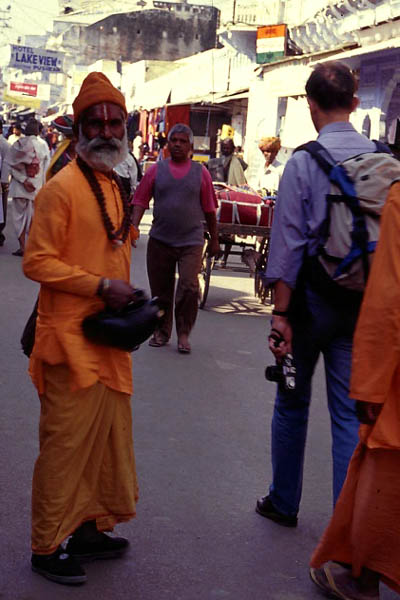
| Holy man, holy Manfred
|
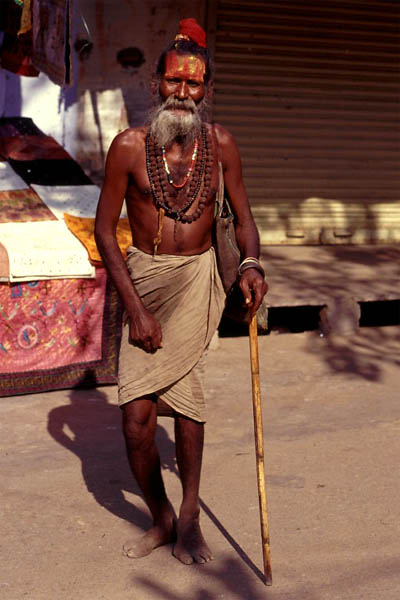
| Another holy man
|
Everybody has some kind of a business, holy or not, whether small with just a scale or dangerous with some venomous snakes dancing to the movement of the flute.
The only dreadful thing was seeing begging children who have been unnaturally crippled and mutilated in such a terrible way that the cause could not have been a birth defect or polio. They could only hop on buttocks with the help of their hand stumps while sticking their twisted legs in the air. One girl had a pretty and intelligent face looking at me with her sad eyes. I am still trying to forget her face (also see my comment in the "'Introduction").

| Holy snakes
|

| Holy sleep
|
Finally we had to leave one more of another fantastic place. Manfred with the night train from Ajmer to Mumbay and I with the morning bus to Delhi via Jaipur
Arriving very late in Delhi was not that ideal. Only found the last rickshaw at the Bikaner House Bus Station and dared to hop on just to see getting somebody else to hop on after the next street corner. I asked the driver to stop right away to let him off or me. He hesitantly stopped and the strange guy jumped off. Before I told him to bring me to the York Hotel, close to the Connaught place. He drove and drove until I got slowly suspicious that he is going in the wrong direction. He also named other better hotels and finally stopped at one and it was not the "York". I went in, asked the man at the reception desk were his hotel was located on the map. He could not tell me (many locals are not able to relate their own street to a map, like their geometrical mind has not been developed). So I took my backpack and just walked out and down the street, but the driver followed me shouting and gesticulating. One Sikh bystander saw that and ask me if I need help. I told him my situation and he did get angry with my driver and asked me to come with him. It turned out that the "York" was in the other direction and very close to the Bikaner House and the rickshaw driver lured me to another hotel where he could get a commission, what I have already suspected. The Sikh happened to have his own taxi just around the corner and offered to take me to the "York", what I grateful accepted. My Sikh still quarreled with the rickshaw driver who wanted his fare now and continuously banged against the window of the taxi while we went off. I knew that Sikhs can mostly be trusted and I was right. He savely dropped me off at the
York Hotel
K-10, 11 Connaught Place
New Delhi 110 001 India
|
for a modest fare so has earned a generous tip.
The "York" was not the best choice I picked up from the Lonely Planet but it was conveniently located, and the room rate for a three star hotel was ok, at that time. Though I have read a comment recently in the internet (posted 2006) of a guy who was told a room rate of 1400 rupees (35 USD) at check-in and when he checked out he was asked 2200 rupees (55 USD) and physically forced by the guard to pay it. So make sure to get it in writing before you check-in.
I stayed in the "York" and around the Connaught Place the last two days before I flew back. There was enough to see and to walk around with many "better" shops and restaurants, while fighting my Ayurveda Cough off as good as I could.
Ok. That was the Indian trip. Third time already, despite the extreme, or just because of it. Anyway, India is always an adventure and a new experience, whether a good one (mostly) or a bad one (like anywhere).
